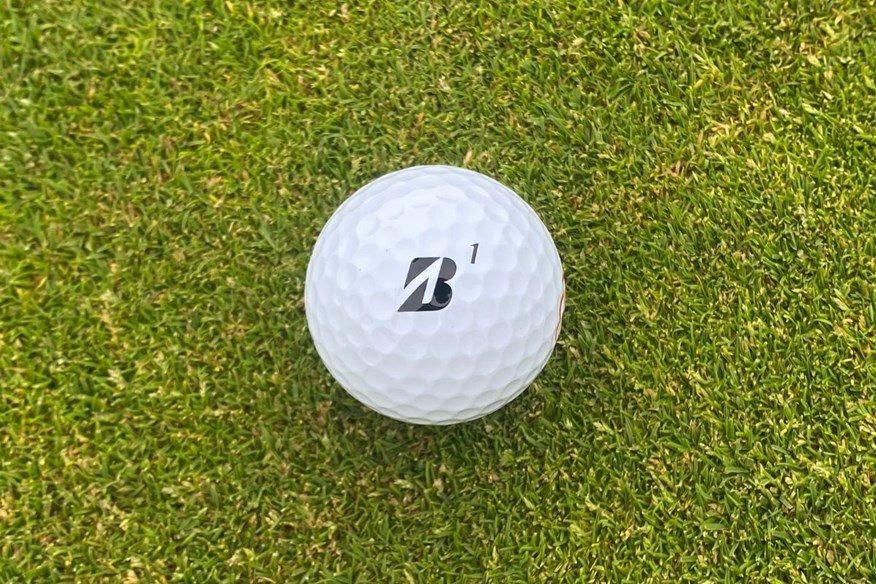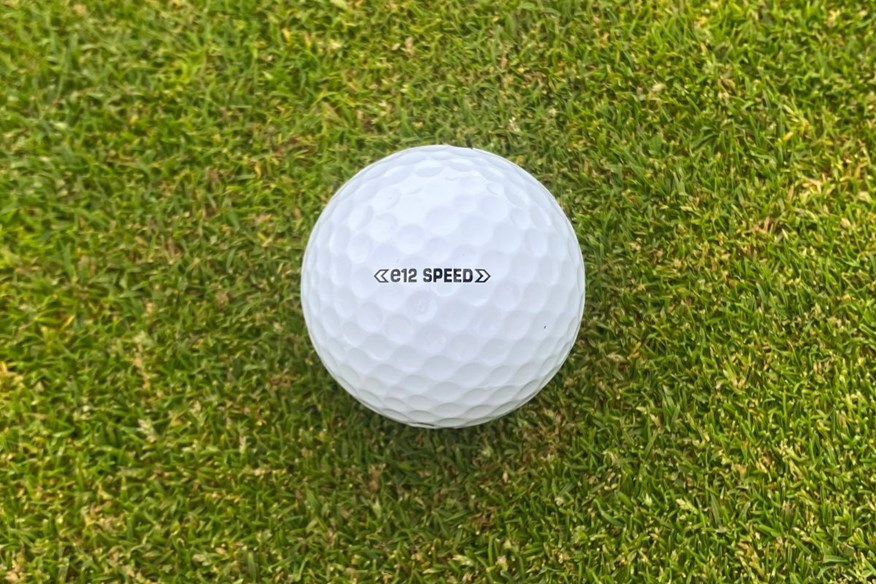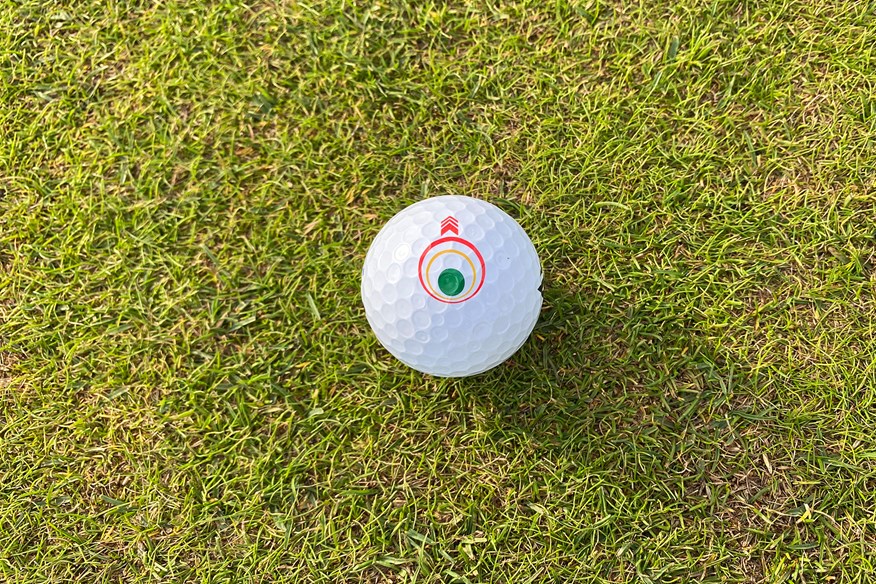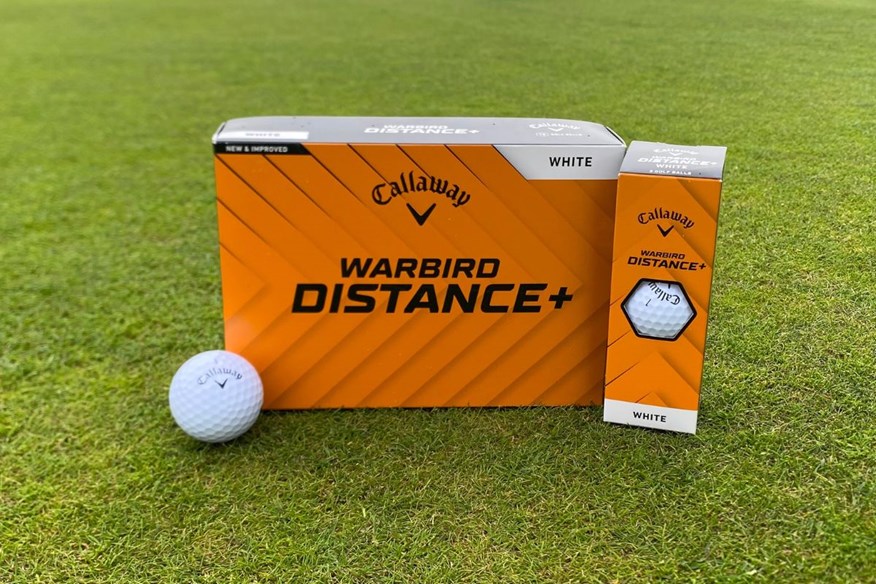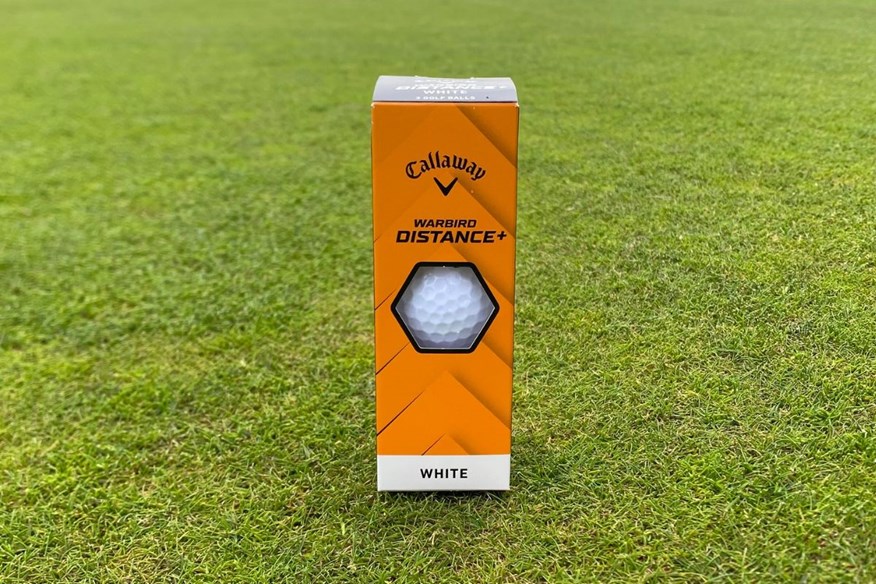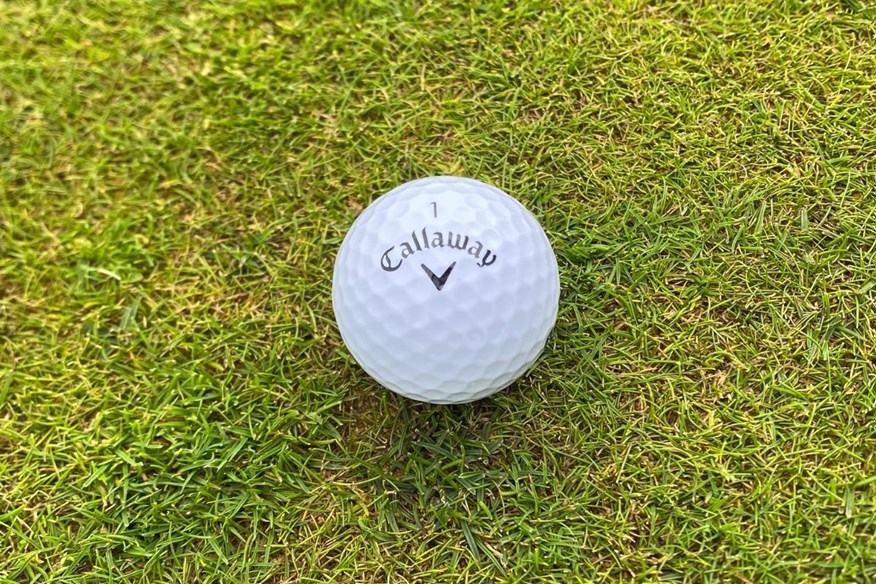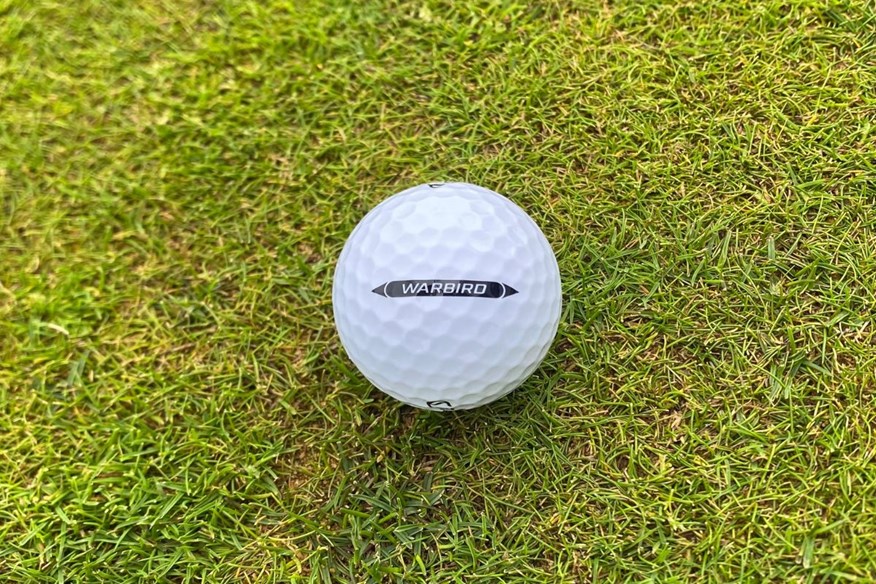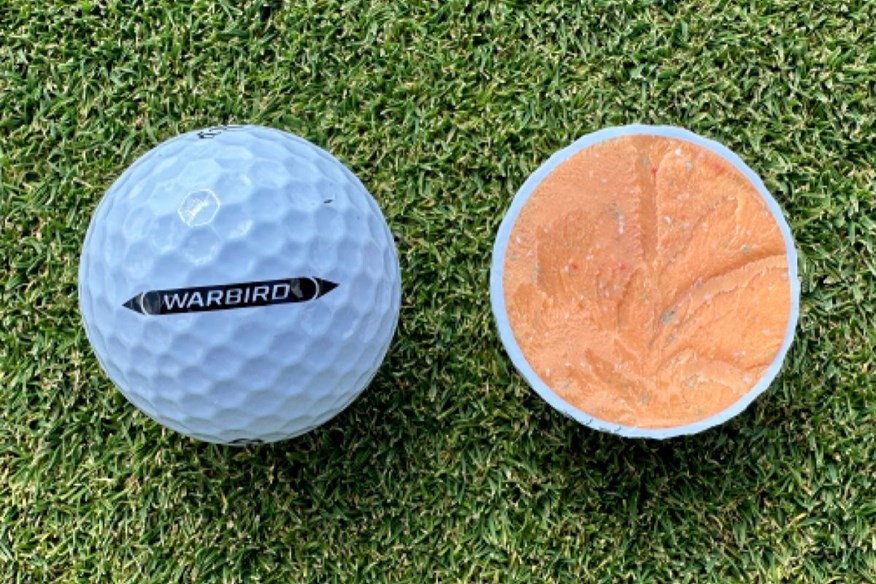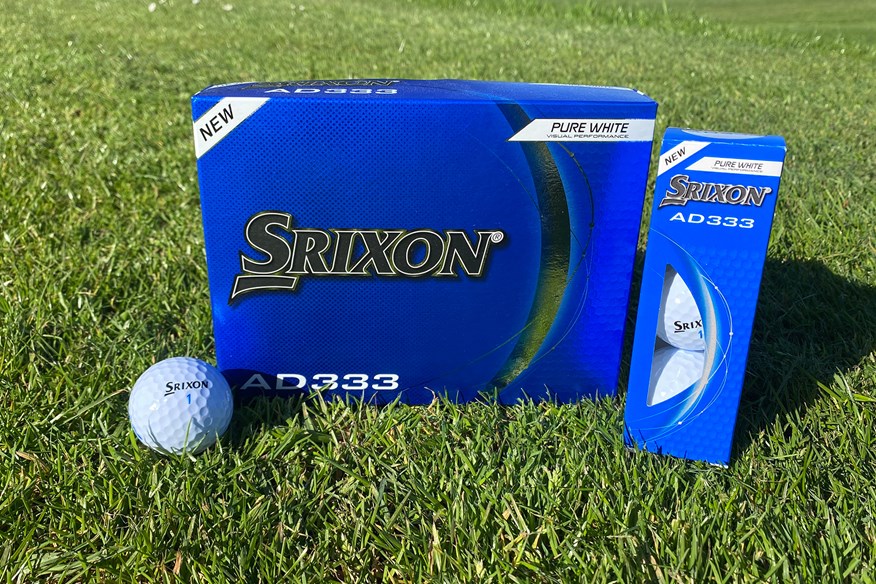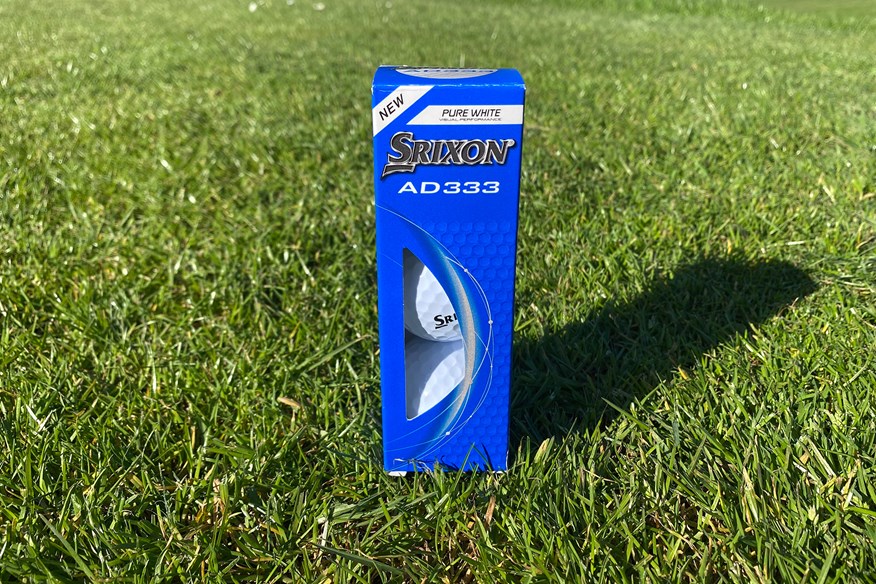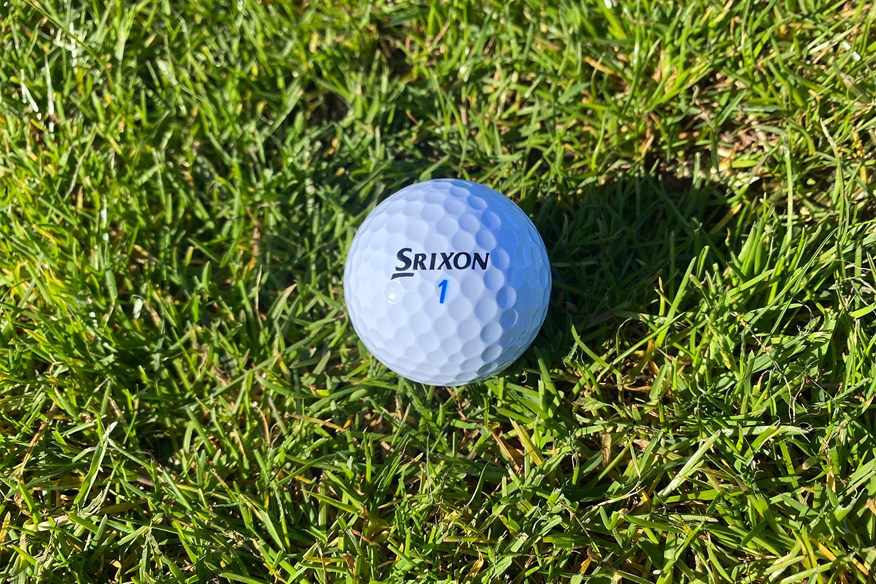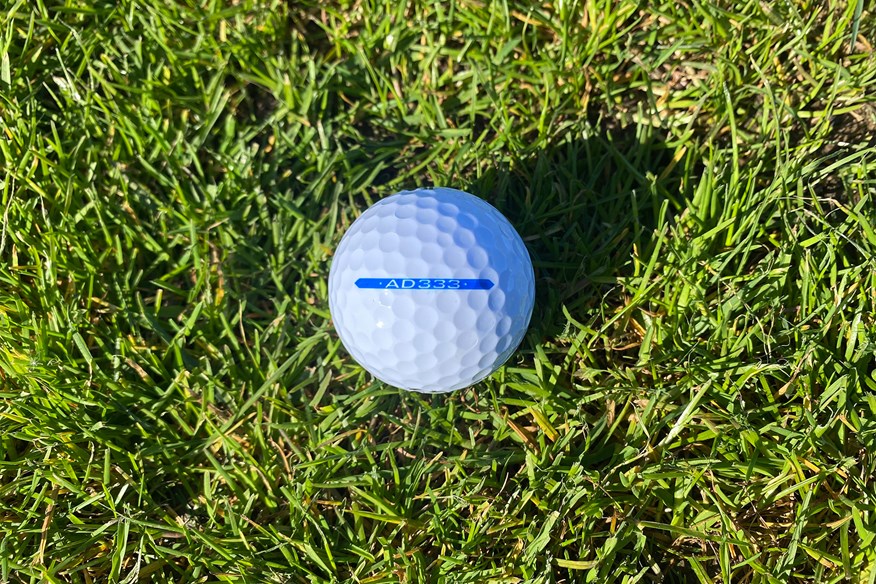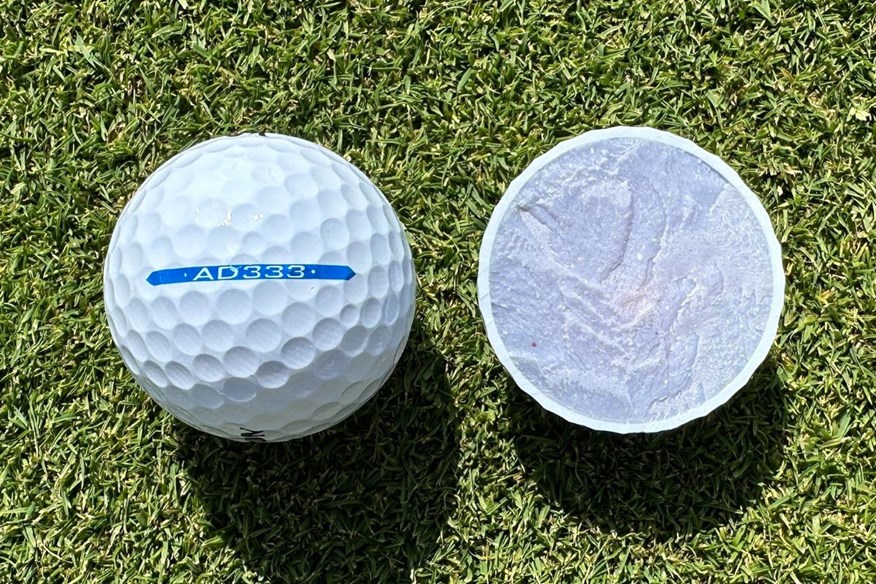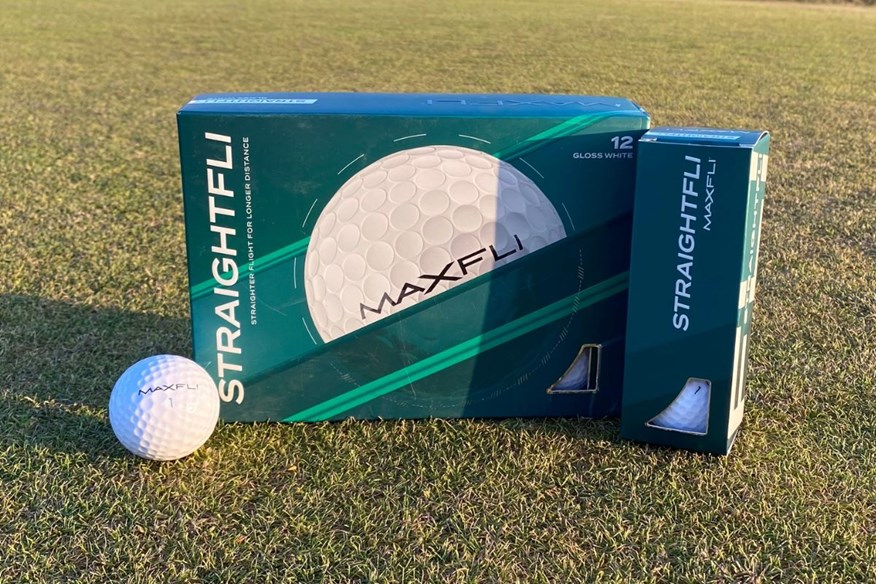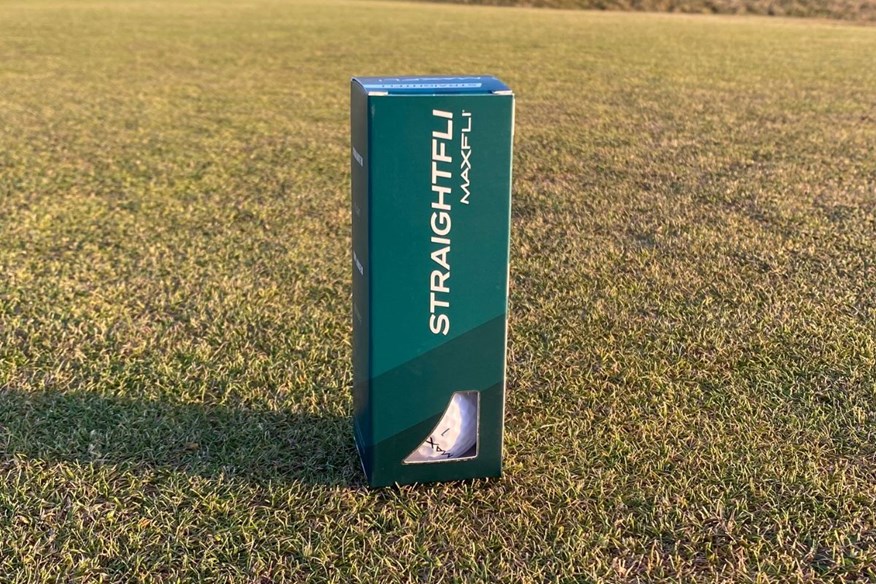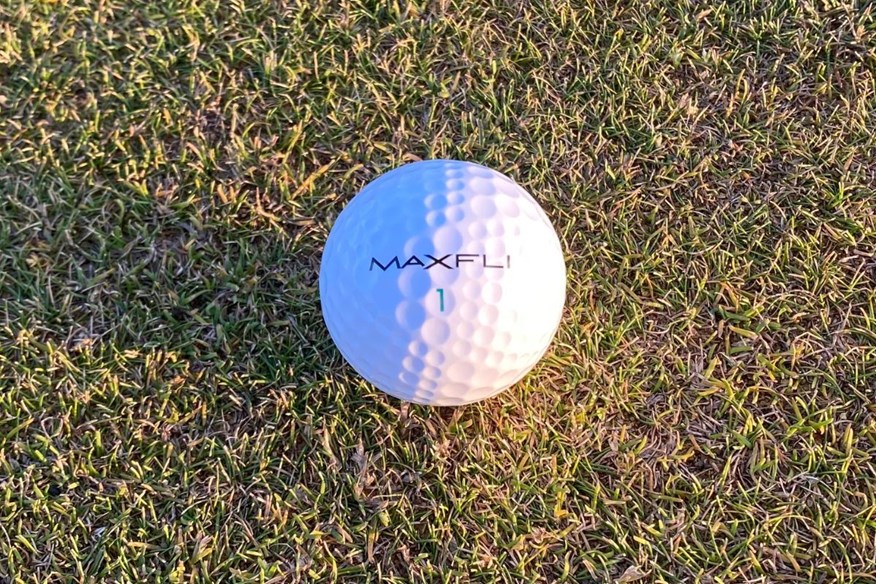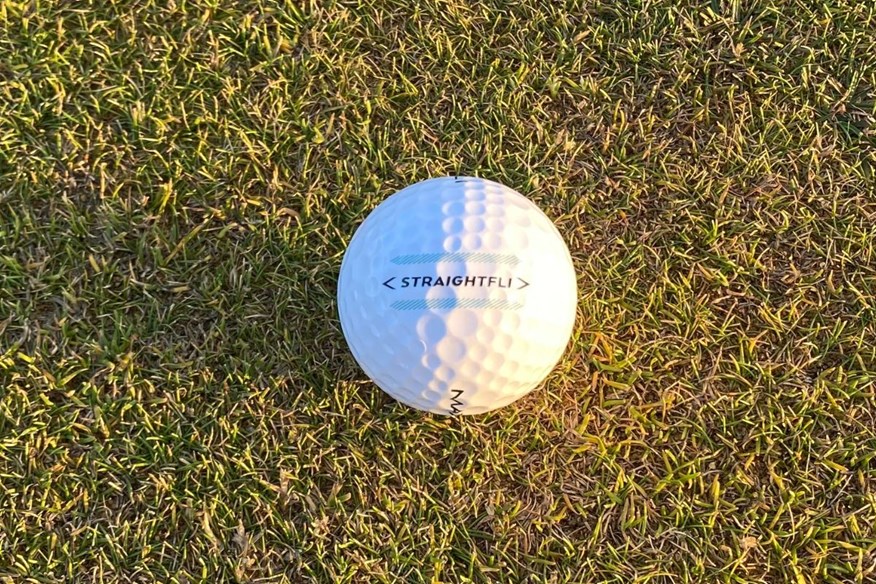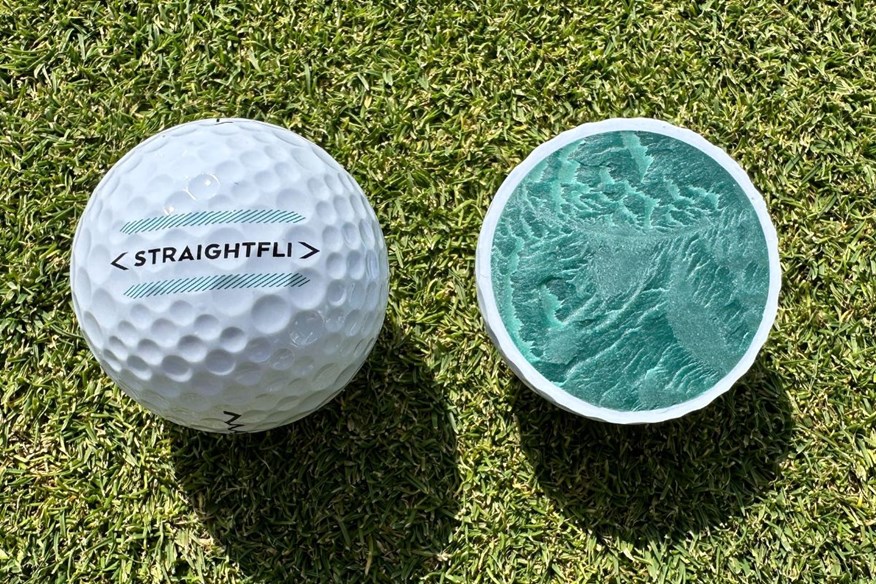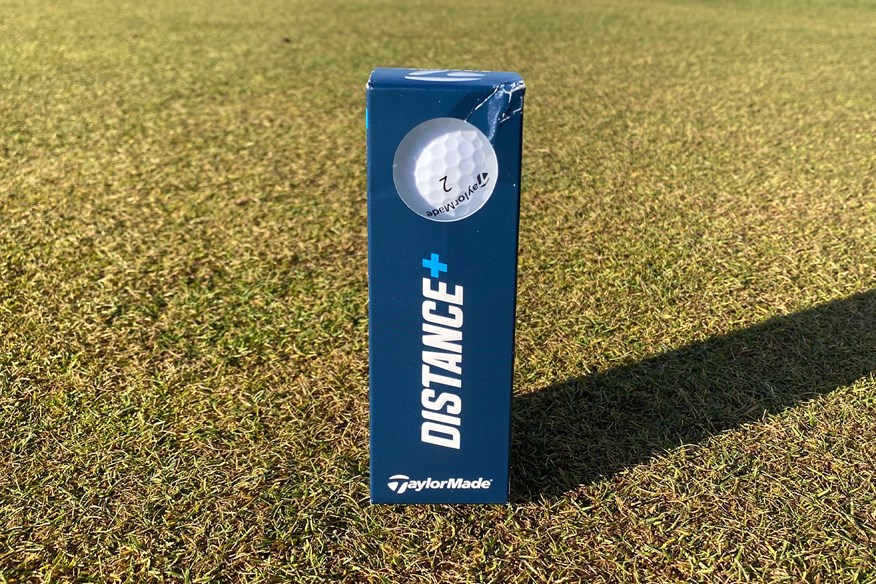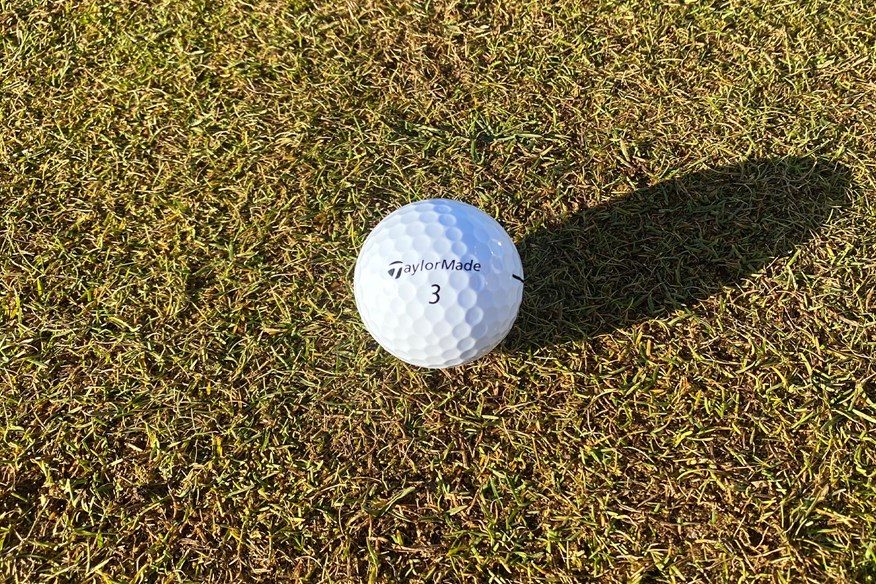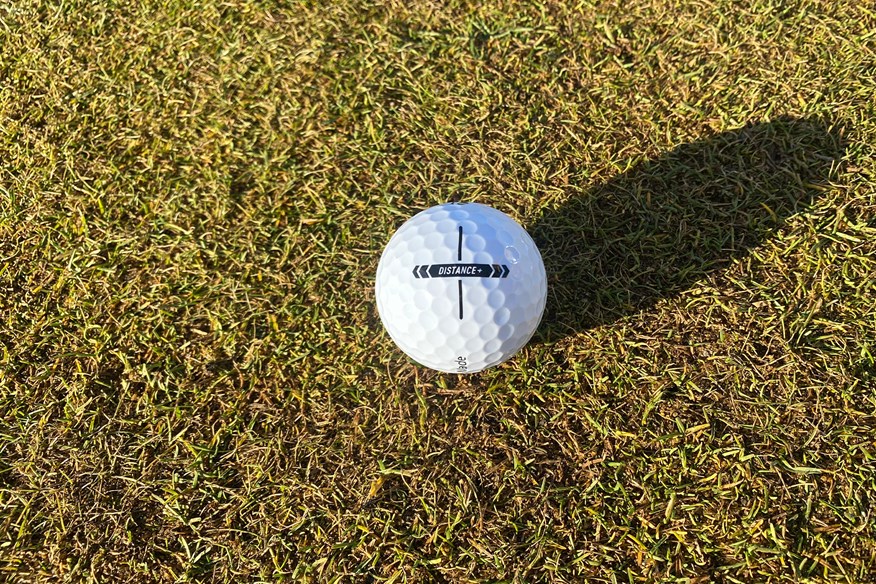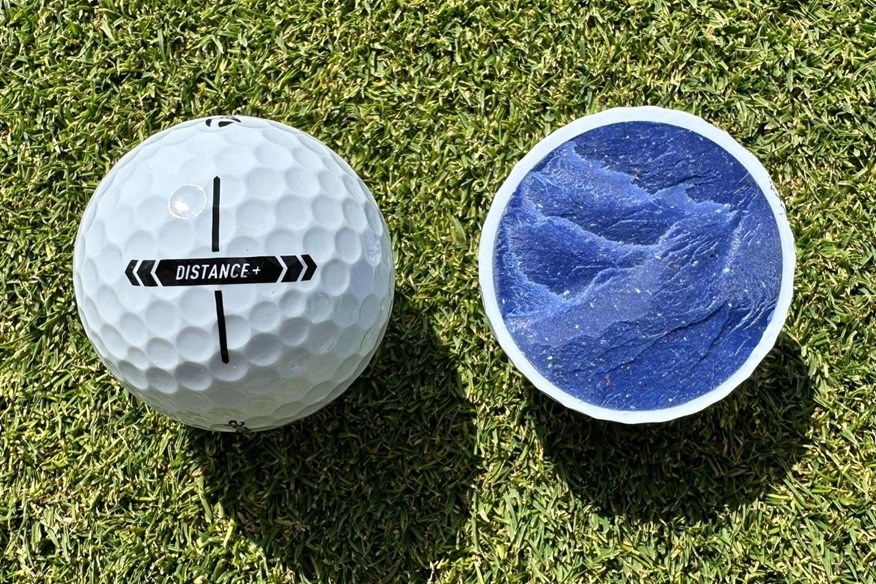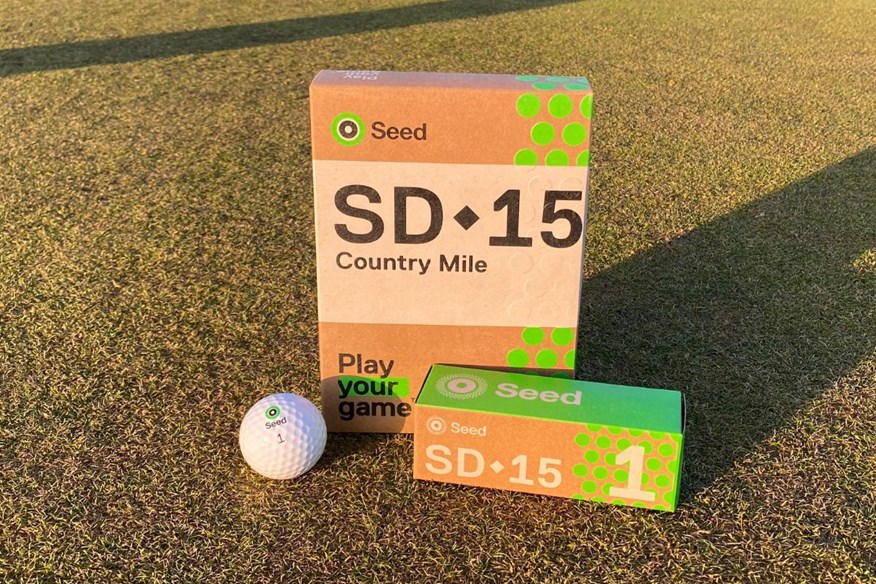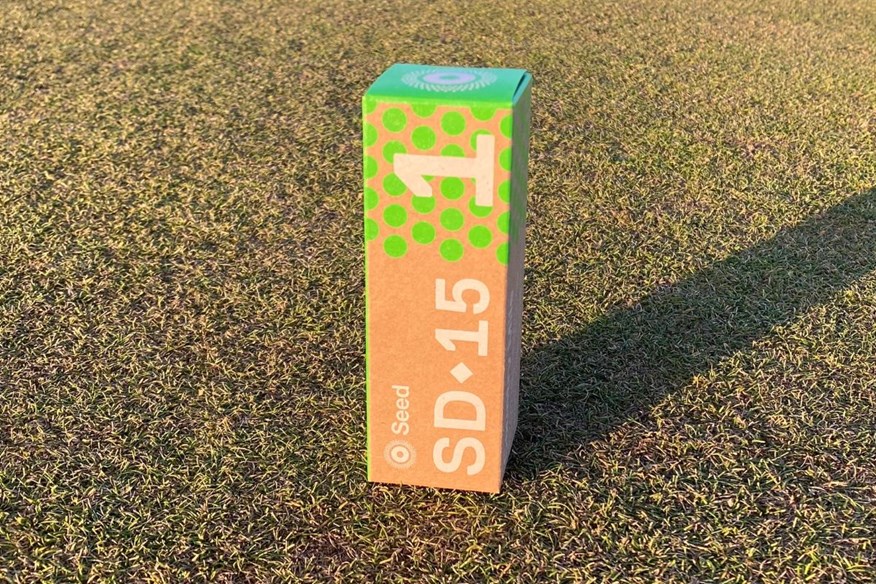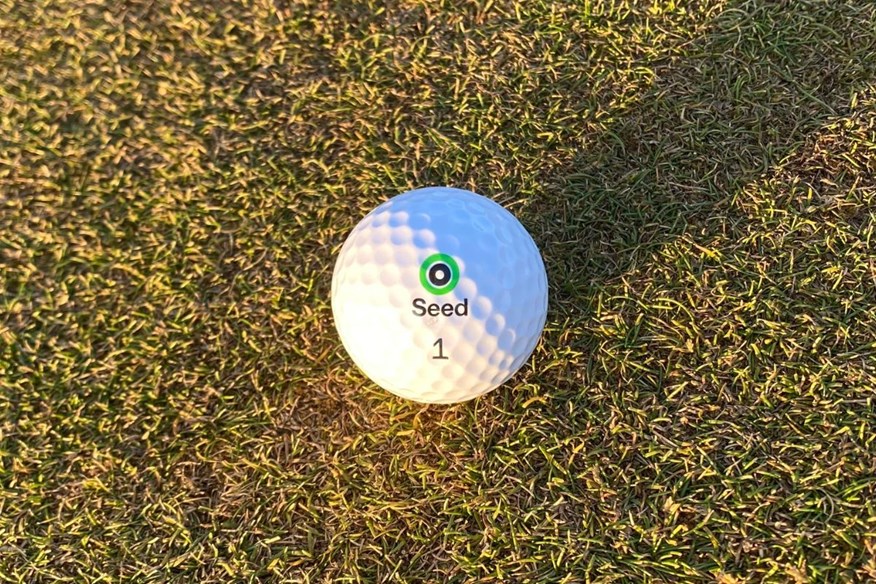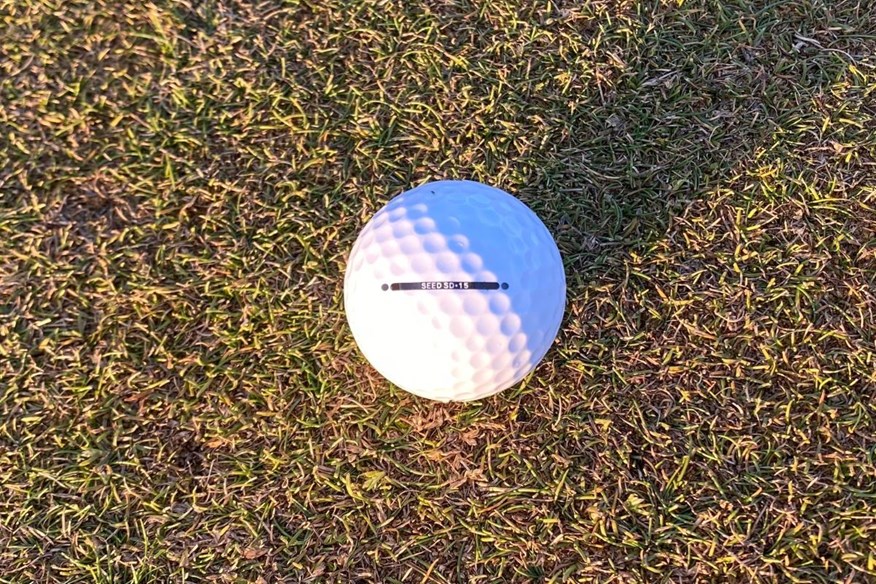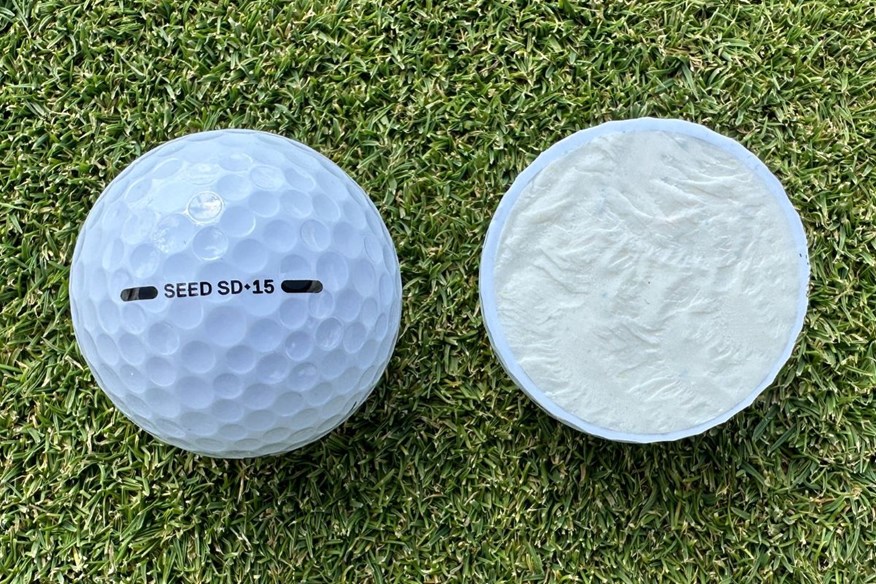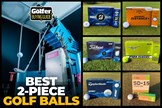Best 2-piece golf balls 2025: 21 models robot tested and played on-course
Last updated:
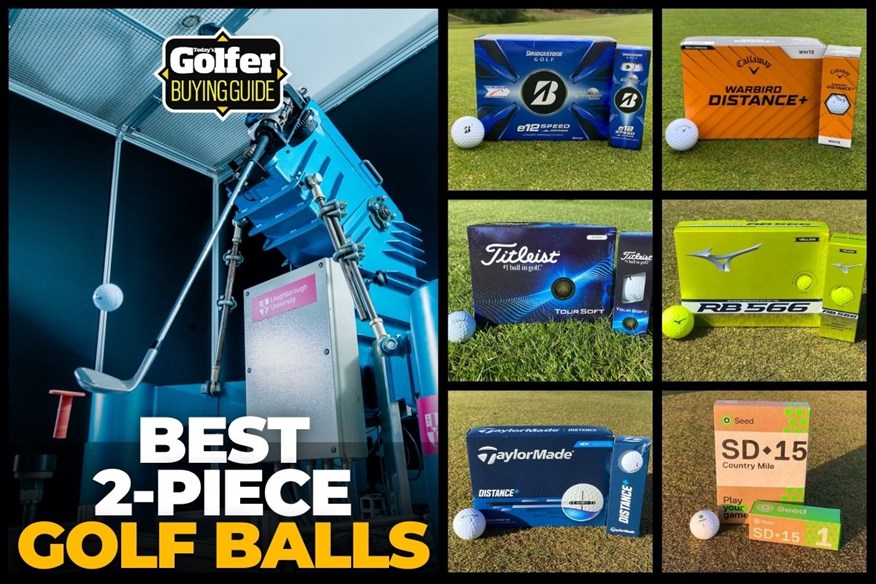
Click here to find out how we conducted our 2025 golf balls test
We’ve tested the most popular and most-played two-piece golf balls on an R&D robot and on-course to help you determine which is the best golf ball for your game
Jump to:
Our 2025 robot test has kicked up a lot of surprises, and while it’s not impossible for two-piece golf balls to challenge the best golf balls in the game, we’ve been blown away by the performance of the best two-piece golf balls.
Two-piece golf balls consist of a cover and core – that’s it. This means manufacturers have the minimum number of layers to work with to fine-tune models. Making it all the more impressive that the best two-piece golf balls challenge the best three-piece, four-piece, and five-piece golf balls.
Of the 62 golf balls we tested in our mammoth robot test, 21 of them were two-piece golf balls from 11 brands. We’ve also tested every golf ball, from the best Direct-to-Consumer (DTC) models to some of the most popular models on Tour, on-course, and on a robot, to provide you with accurate and extensive robot data, as well as an expert personal verdict. Click the links below to see how we completed this year’s robot test and to find out exactly how we test golf equipment.
- 2025 golf ball robot test: 62 golf balls, 2,232 shots, 50,000 data points… find out what’s No.1 for you
- How we test golf equipment at Today’s Golfer
Two-piece golf balls heavily feature among the best value golf balls, as well as the best cheap golf balls. Models sporting two layers tend to be the most inexpensive on the market because they are only made up of a core and cover, so less technology and materials are needed.
Best two-piece golf balls: At a glance
Many of the best golf balls for beginners and high-handicappers are two-piece golf balls, and that’s mainly price-related. If you’re a new golfer or someone not looking to break course records, two-piece models are ideal because when you inevitably lose one (or more), it’s not going to hurt as much if you lose one of the best premium golf balls.
That’s not to say golf balls in this category are exclusive to those golfers. If you’re a single-figure handicapper, or if you just want to play with a golf ball constructed of fewer layers, that’s absolutely fine.
A lot of two-piece models are distance-oriented, but that’s not to say those golf balls only offer distance – as our robot test results show.
Finding a quality two-piece golf ball can save you a ton of money without sacrificing much, if any, performance. If you’re fortunate to find a golf ball in this category that enables you to play your best golf, this is a very easy and cost-effective fix that will allow you to spend money elsewhere on your golf game.
On that point, if a two-piece golf ball doesn’t work for you, don’t force it, you’ll enjoy the game much more if you up your budget and look at a three-piece golf ball, four-piece, or five-piece model.
Best two-piece golf balls 2025
Gold medal for tee to green performance at all three driver swing speeds, off-the-tee performance, and approach play performance
Let's start by running through all of the e12 Speed's awards. Gold medal for tee to green performance at 114mph, 93mph, and 78mph, off-the-tee performance, and approach play performance.
The only area where the e12 Speed didn't rank is short game performance, where it finished in fourth, by 9rpm (5,951).
The e12 Speed is the highest-performing Bridgestone golf ball, factoring in how it performed in every area. Its best performance has to be off the tee. At 114mph, this golf ball was 2.4 yards longer and 0.8mph faster than the second-longest and second-fastest model, and fourth-longest overall (273.9yds).
At 93mph, the e12 Speed is the second longest (209.7yds) and fastest (134.1mph) 2-piece golf ball. But, at 78mph, this golf ball is back at the top of the table for both (161.3yds and 113.2mph).
Combine that performance with its dominating approach play performance, and not only do you have an amazing golf ball off the tee, but you have a fantastic golf ball from tee to green.
The e12 Speed is a golf ball I urge every golfer to consider. This is hands down the best value golf ball in the entire test, and as one of the best performers of all 62 models tested, what harm do you have in giving it a go?
On-course verdict
I was extremely surprised by the on-course performance of the Bridgestone e12 Speed, and having played with this golf ball on a couple of occasions, it has never disappointed.
The first time I played with the e12 Speed had me questioning if it definitely is a two-piece golf ball because it performs much closer to other three-piece Tour-level models.
The Bridgestone golf ball I' like most'm most fond of is the Tour B XS, and I think this performs very similarly - if not better.
The feel is slightly firmer than the Tour B XS, which is something I appreciate, and it does deliver more feedback and response throughout the bag.
Overall, I'm very impressed with the tee to green performance of the e12 Speed. Despite being a two-piece model, I wouldn't be quick to dismiss it.
Pros
- Perfroms more like a premium golf ball
- Outstanding tee to green performance
- Amazing feedback and response
Cons
- Very difficult to criticize
| Carry distance (yds) | Driver 114mph - 273.9 | Driver 93mph - 210 | Driver 78mph - 161.3 | 7-iron - 157.6 |
| Ball speed (mph) | Driver 114mph - 164 | Driver 93mph - 134.1 | Driver 78mph - 113.2 | 7-iron - 109.2 |
| Backspin (rpm) | Driver 114mph - 2,680 | Driver 93mph - 2,574 | Driver 78mph - 2,317 | 7-iron - 4,467 | Pitch - 5,951 |
| Launch angle (°) | Driver 114mph - 11.4 | Driver 93mph - 12.9 | Driver 78mph - 14.1 | 7-iron - 21.3 | Pitch - 30.7 |
| Descent angle (°) | Driver 114mph - 37.6 | Driver 93mph - 31.8 | Driver 78mph - 27 | 7-iron - 45.1 | Pitch - 36 |
| Peak height (yds) | Driver 114mph - 33 | Driver 93mph - 22.3 | Driver 78mph - 15.5 | 7-iron - 30 | Pitch - 6.9 |
| Compression (psi) | 103 |
- Optimal Flight System
- Fast gradational core
- MindSet technology
- 330 dimples
- 2-Piece construction
- Available in white only
Silver medal for tee to green performance at 93mph and 78mph and short game performance
The Warbird Distance+ is Callaway's cheapest golf ball, but it certainly doesn't perform as though it is. This model scooped up the second-most awards in the two-piece category.
Tee to green performance is incredibly strong at all three swing speeds. The Warbird Distance+ won silver at 93mph and 78mph, and bronze at 114mph. Distance is definitely a strong factor, being the third-best golf ball off the tee in this category.
However, this golf ball isn't purely a distance model (despite it being in its name). For short game performance, the Warbird Distance+ is the second-highest-spinning two-piece model (5,963rpm) and the third-highest-spinning Callaway golf ball.
We're really impressed by the overall performance of the Warbird Distance+. It's firmly put this golf ball on our radar, and with its test results, it should be for you, too!
On-course verdict
I didn't have particularly high hopes for the Callaway Warbird Distance+ given its price, construction, and name, but I'm happy to have been proven wrong.
The Warbird Distance+ doesn't feel the greatest. It's slightly clicky and clunky, which doesn't make the feedback and response very pleasant, but if you can look past that, this is a solid golf ball from tee to green.
Despite being a distance golf ball, the Warbird Distance+ offers much more than solely distance. This golf ball produces high-spin when attacking pins with an iron and wedge - something you don't always expect from a distance golf ball, but it's always appreciated.
Although the Warbird Distance+ offers more than distance, distance is very impressive with this model, thanks to the reduced spin. The carry distance is long, but the ball continues to roll a long way, delivering amazing total distance.
The Warbird Distance+ might not jump out as a must-have golf ball, but you won't be disappointed if you give it a go - I most certainly wasn't.
Pros
- Solid tee to green performance
- Surprisingly strong short-game performance
- Impressive distance
Cons
- Not the nicest feel
| Carry distance (yds) | Driver 114mph - 270.9 | Driver 93mph - 209.2 | Driver 78mph - 161.3 | 7-iron - 157.9 |
| Ball speed (mph) | Driver 114mph - 163 | Driver 93mph - 133.7 | Driver 78mph - 113 | 7-iron - 108.7 |
| Backspin (rpm) | Driver 114mph - 2,683 | Driver 93mph - 2,611 | Driver 78mph - 2,346 | 7-iron - 4,273 | Pitch - 5,963 |
| Launch angle (°) | Driver 114mph - 11.1 | Driver 93mph - 13 | Driver 78mph - 14.2 | 7-iron - 21.6 | Pitch - 30.7 |
| Descent angle (°) | Driver 114mph - 36.8 | Driver 93mph - 32.2 | Driver 78mph - 27.3 | 7-iron - 44.9 | Pitch - 36.1 |
| Peak height (yds) | Driver 114mph - 31.7 | Driver 93mph - 22.5 | Driver 78mph - 15.6 | 7-iron - 29.9 | Pitch - 6.9 |
| Compression (psi) | 92 |
- Extra-large, high-energy core
- Hex aerodynamics
- 332 dimples
- 2-Piece construction
- Available in white and yellow
Gold medal for short game performance
Best two-piece golf ball for greenside spin


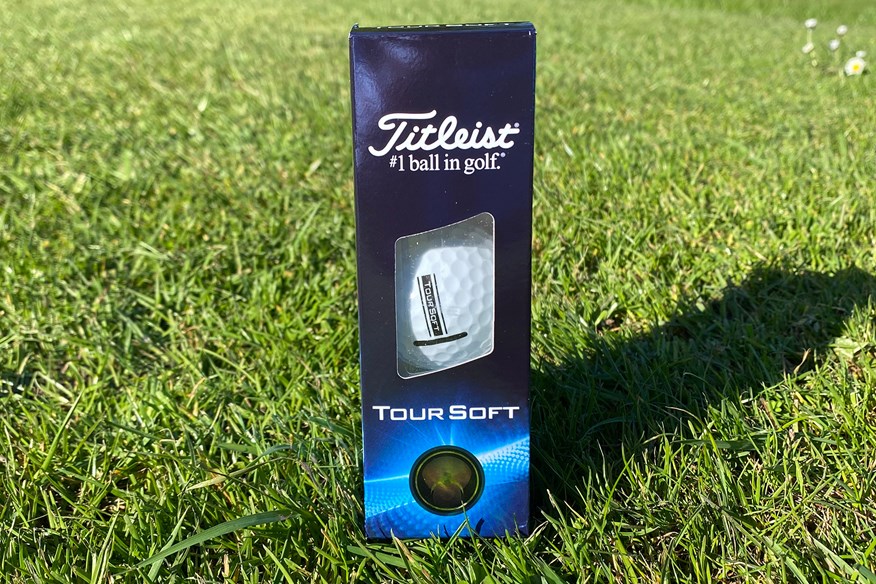
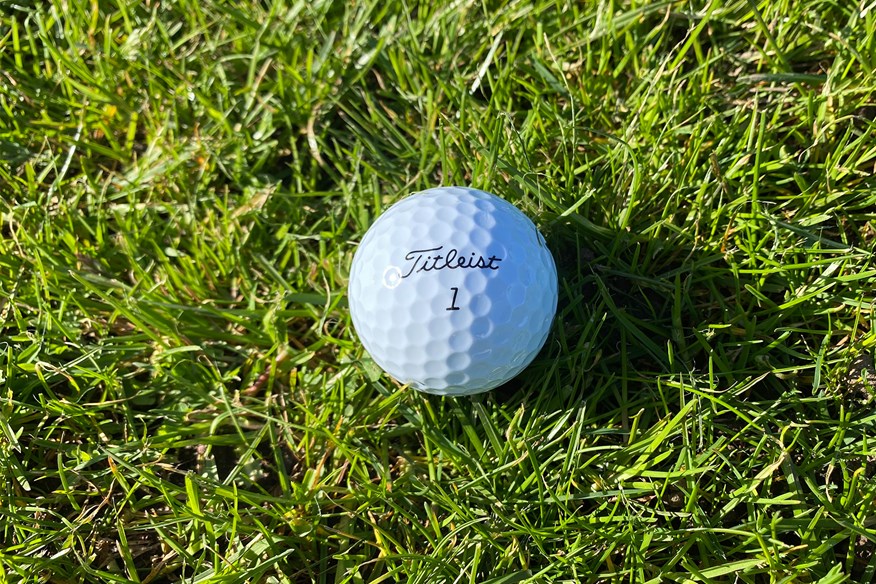
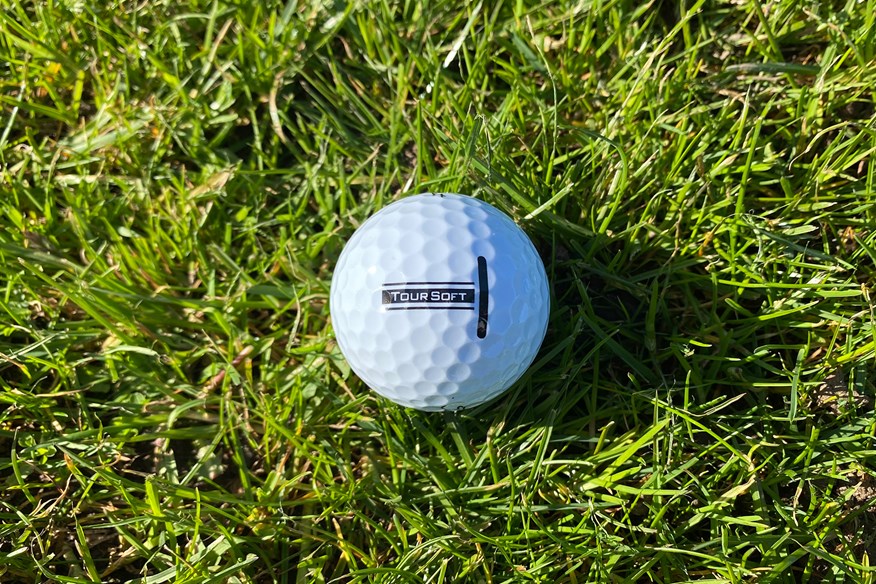
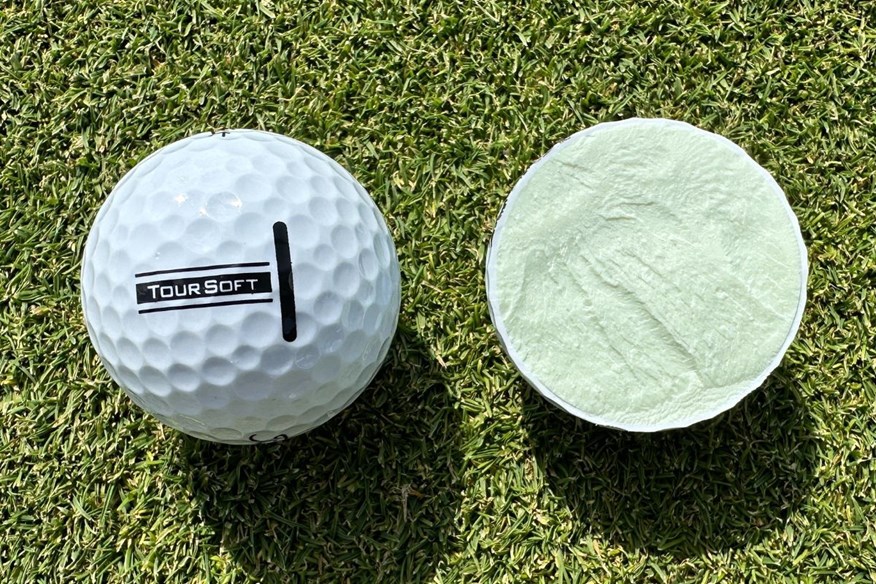
Moving to approach play, this golf ball is the bronze medal winner in this area. Tour Soft produces the second-highest spin (4,774rpm) and second-steepest descent angle (45.2), but it is the shortest two-piece golf ball (154.2yds).
Off-the-tee performance has this golf ball very closely matched with Titleist's distance two-piece golf ball - Velocity. Granted, Tour Soft is slightly shorter and slower at all three swing speeds. However, giving up less than a yard off the tee at every swing speed is probably worth it for the approach play and short game performance gains. It performed well enough at 114mph to earn the silver medal for tee to green performance.
Tour Soft is a super consistent golf ball in every area. If you're looking for a two-piece golf ball that'll do everything, this golf ball needs to be on your mind.
On-course verdict
This is one of the best-feeling golf balls I've had the pleasure of playing with purely because of how soft it is. I'm not always a fan of soft golf balls, but when they feel as good as the Tour Soft does, there's nothing to dislike.
The feedback and response throughout the bag is exactly what you want with a soft golf ball, but it's most enjoyable when playing around the greens because you can really feel the ball interacting with the grooves.
Around the greens, this ball generates amazing spin and control that's capable of challenging the best high-spin golf balls.
Moving away from the green, I didn't notice anything special about the Tour Soft's performance, but in the same breath, there's nothing to criticize. If anything, this ball performs better than you would expect from a two-piece model.
The Titleist Tour Soft is great value, and if you want a soft-feeling golf ball, this is the model you want.
Pros
- Amazing short-game spin and control
- Incredibly soft and responsive
- Great value
Cons
- Short distance in iron play
| Carry distance (yds) | Driver 114mph - 271.3 | Driver 93mph - 208.5 | Driver 78mph - 160.4 | 7-iron - 154.2 |
| Ball speed (mph) | Driver 114mph - 163.3 | Driver 93mph - 133.4 | Driver 78mph - 112.8 | 7-iron - 108.3 |
| Backspin (rpm) | Driver 114mph - 2,776 | Driver 93mph - 2,731 | Driver 78mph - 2,438 | 7-iron - 4,774 | Pitch - 6,075 |
| Launch angle (°) | Driver 114mph - 11.1 | Driver 93mph - 13 | Driver 78mph - 14 | 7-iron - 21.1 | Pitch - 30.4 |
| Descent angle (°) | Driver 114mph - 37.6 | Driver 93mph - 32.8 | Driver 78mph - 27.3 | 7-iron - 45.2 | Pitch - 35.7 |
| Peak height (yds) | Driver 114mph - 32.6 | Driver 93mph - 22.8 | Driver 78mph - 15.4 | 7-iron - 29.5 | Pitch - 6.8 |
| Compression (psi) | 95 |
- Large, faster core
- Reformulated thin fusablend cover
- Proprietary quadrilateral dipyramid dimple design
- 346 dimples
- 2-Piece construction
- Available in white, green, and yellow
- An alternative model is AIM 360
Bronze medal for short game performance
Best Mizuno golf ball for short-game performance
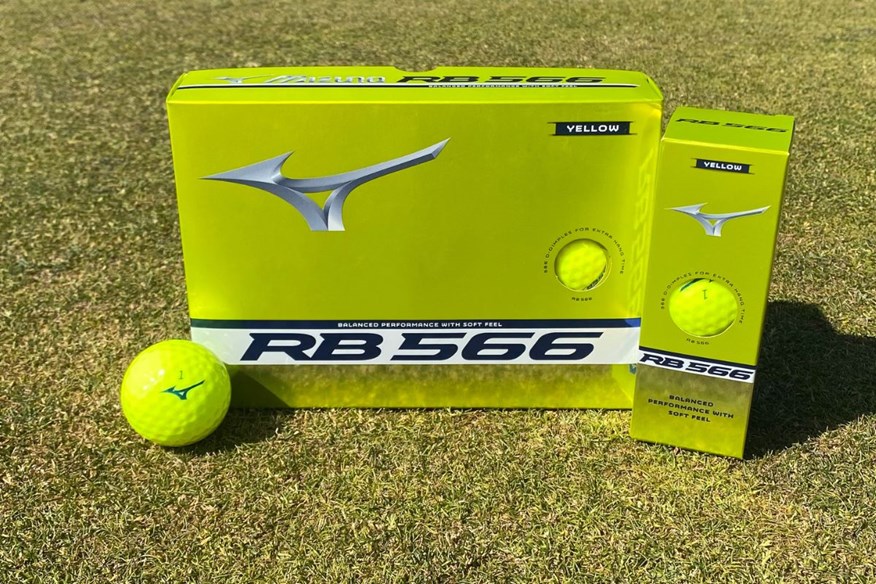

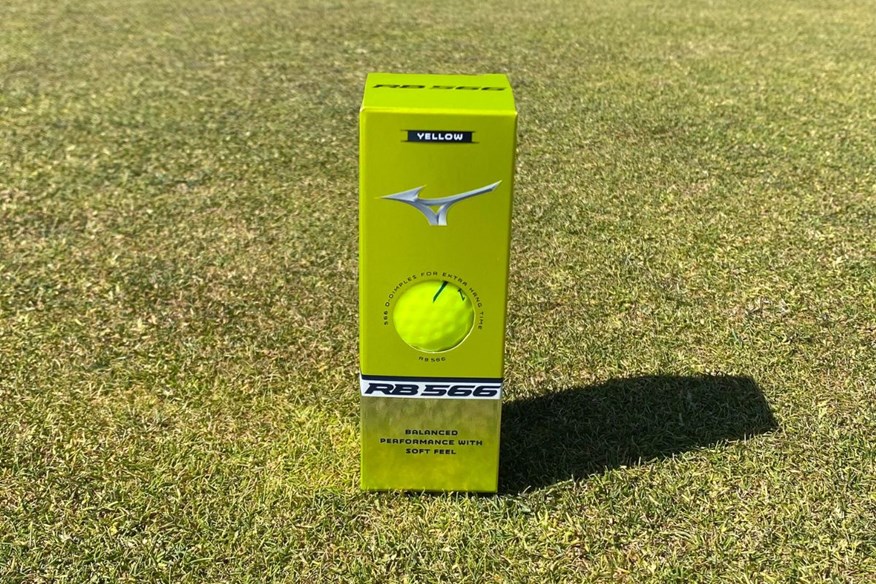
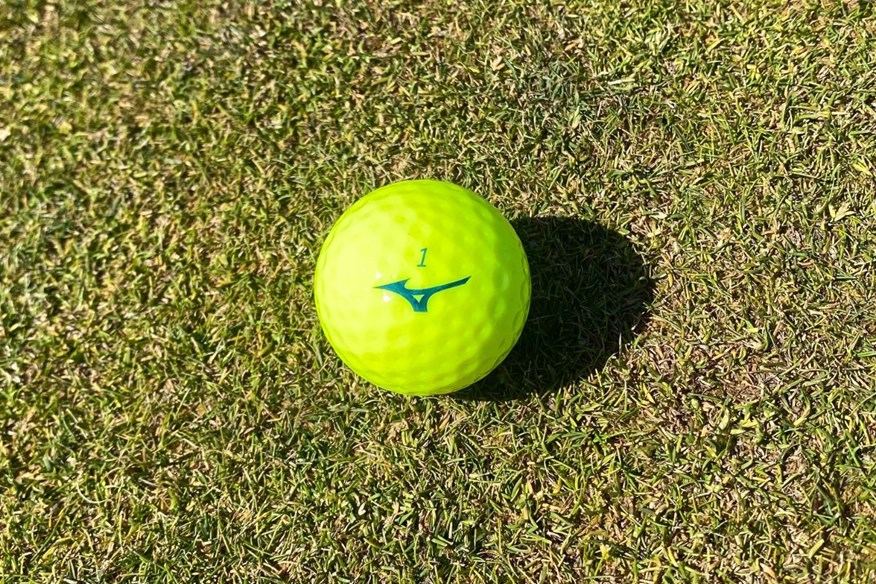
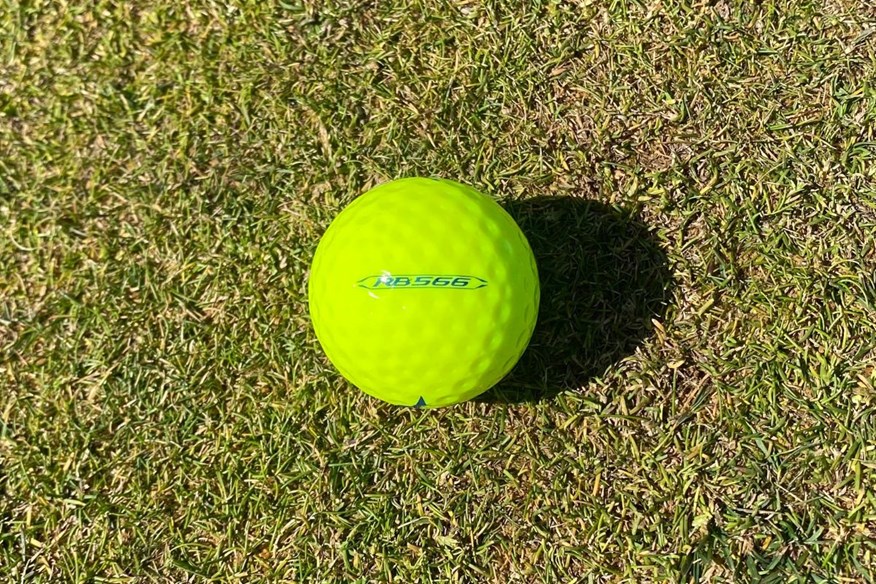
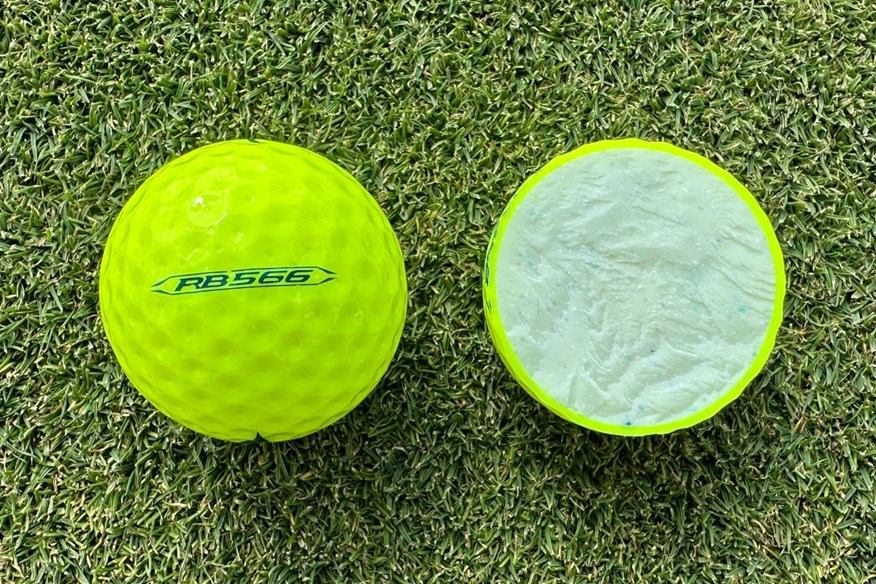
Probably not. However, it is the bronze medal winner for short game performance (5,960rpm). Although the dimple technology isn't specifically designed to generate spin, the RB 566 is the highest-spinning golf ball in approach play (4,947), and it lands with the steepest descent angle (45.3°).
Off the tee is where the RB 566 should make the most impact by reducing spin. It's below the test average for backspin at 93mph and 78mph, and bang on the average at 114mph. This makes it a very average performer for off-the-tee performance.
It might not be what Mizuno are going for, but I'd recommend the RB 566 for anyone looking for a high-spin golf ball. It's definitely a unique golf ball, and for that reason, it is interesting. However, the RB 566 should only tempt you if you're looking to add spin to your game.
On-course verdict
There's something very exciting about a unique golf ball, and so that's exactly how I felt when testing the Mizuno RB 566 with its 566 dimples.
I didn't really know what to expect from this golf ball, but I definitely wasn't expecting it to confuse me as much as it did. I had a lot of enjoyment playing with the RB 566 because I was able to throw the ball at the pin and watch it stop. I wasn't expecting it to spin as much as it did.
This golf ball was high-spinning for me throughout the bag. Off the tee, I was struggling to stop the ball from spinning. I definitely had contrasting emotions off the tee to approaching the green.
The feel is soft, and it's not the most responsive, which I'm not massively keen on.
Overall, I feel as though this is a high-spinning golf ball, almost to its detriment because it balloons off the tee. However, a different golfer might think otherwise, especially if you have a slower swing speed.
Pros
- Great short-game spin and control
- Good value
- Solid performance from tee to green
Cons
- Struggled to reduce spin off the tee on the course
| Carry distance (yds) | Driver 114mph - 268.6 | Driver 93mph - 207.9 | Driver 78mph - 160.2 | 7-iron - 154.8 |
| Ball speed (mph) | Driver 114mph - 161.9 | Driver 93mph - 133.3 | Driver 78mph - 112.6 | 7-iron - 109.1 |
| Backspin (rpm) | Driver 114mph - 2,719 | Driver 93mph - 2,553 | Driver 78mph - 2,381 | 7-iron - 4,947 | Pitch - 5,960 |
| Launch angle (°) | Driver 114mph - 11.1 | Driver 93mph - 13 | Driver 78mph - 14.1 | 7-iron - 20.7 | Pitch - 30.6 |
| Descent angle (°) | Driver 114mph - 36.9 | Driver 93mph - 31.6 | Driver 78mph - 27.2 | 7-iron - 45.3 | Pitch - 36 |
| Peak height (yds) | Driver 114mph - 31.5 | Driver 93mph - 21.9 | Driver 78mph - 15.4 | 7-iron - 29.6 | Pitch - 7 |
| Compression (psi) | 92 |
- Large soft compression core
- Micro dimple design
- Ionomer cover
- 566 dimples
- 2-Piece construction
- Available in white, yellow, and orange
Titleist's best 2-piece golf ball for off-the-tee performance
Best two-piece Titleist golf ball for distance
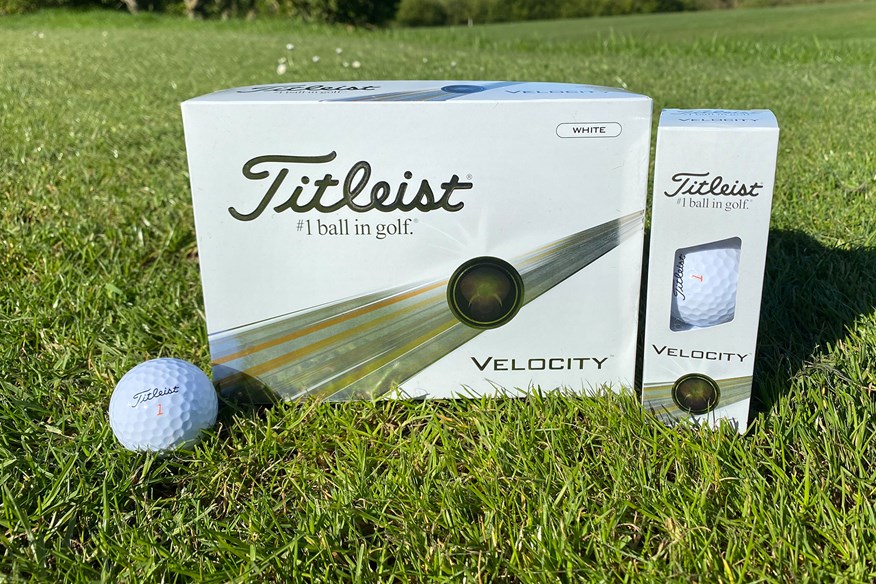


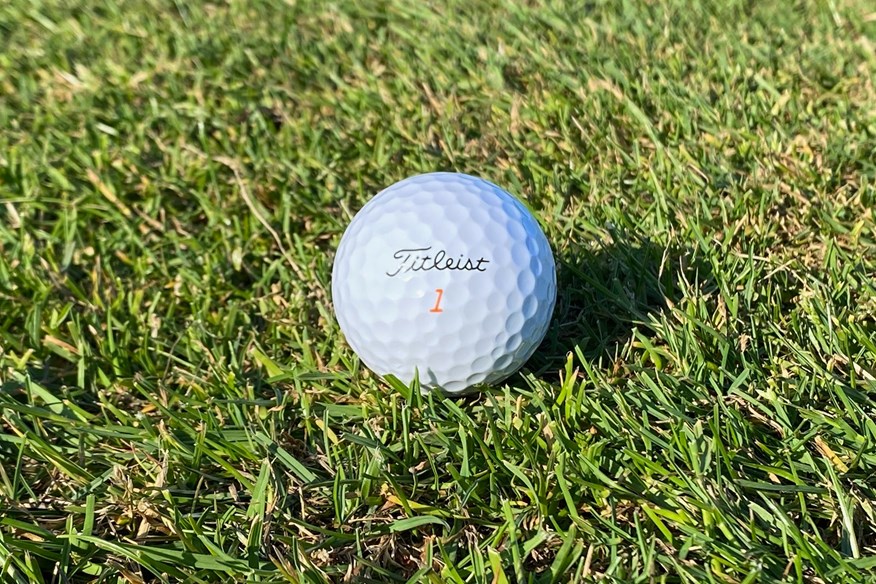
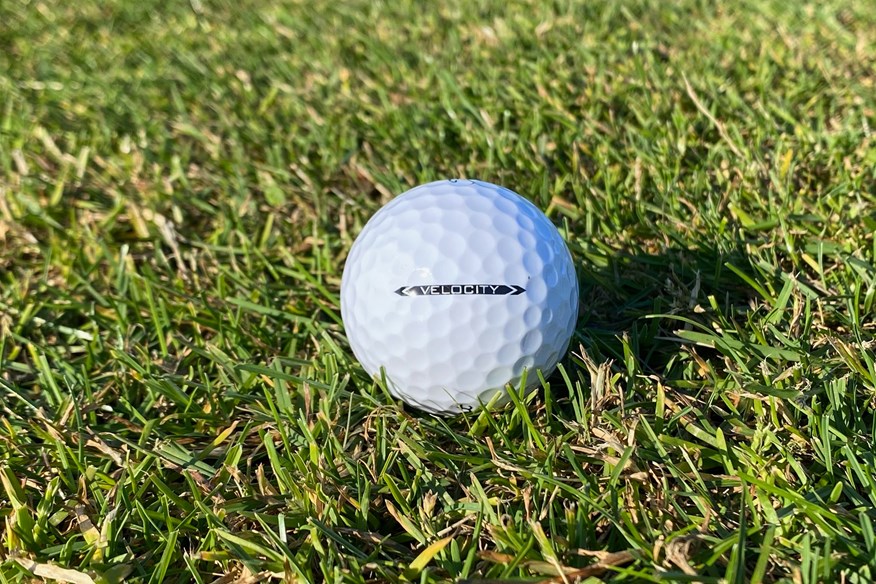
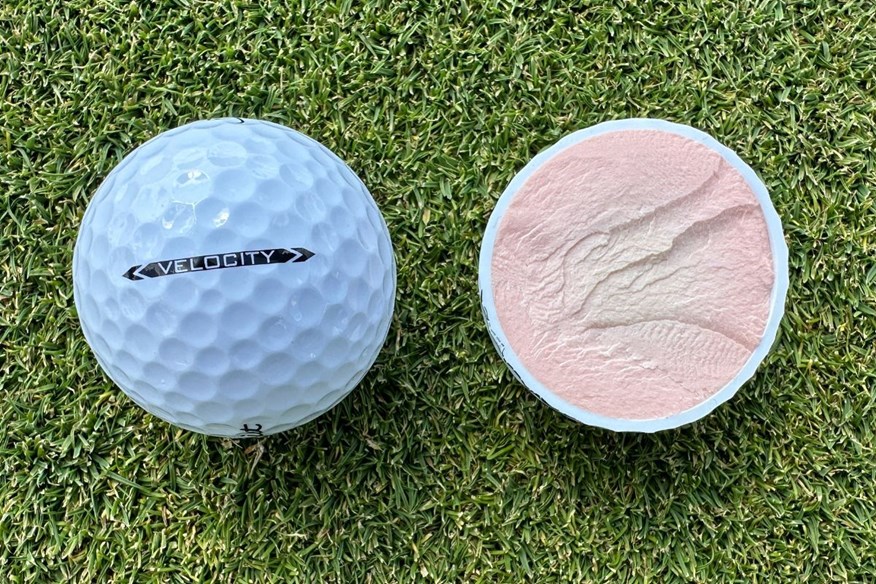
Across all three swing speeds, the Velocity is the fourth-best two-piece golf ball for overall performance off the tee. We fully expected the Velocity to perform well off the tee because it's a distance golf ball, but if we're being honest, we didn't expect it to outperform the four-piece Pro V1x.
The velocity delivered its best performance at 114mph. At the quickest swing speed we tested, the Velocity produced 271.5 carry yards and 163.2mph ball speed.
In approach play, the Velocity is the lowest-spinning golf ball (3,081rpm) and longest (160.6yds) out of all 62 models we tested. That's potentially expected given it's a distance golf ball.
However, the Velocity's short game performance is much better than we expected. This golf ball is the fifth-highest-spinning two-piece model, with 5,789rpm.
The Titleist Velocity delivers competitive distance and overall performance for all golfers. You're guaranteed distance, but you're also getting a golf ball that can perform around the greens.
On-course verdict
I'm quite the fan of Velocity. In the right hands, this can be a very strong performing golf ball. However, in the wrong hands, it can majorly hinder your game.
For my game, off the tee, Velocity performs very closely to the Pro V1x, but as I approach the green, distance begins to outweigh spin, which isn't something I require.
If you're a golfer who's looking to reduce spin and gain distance, Velocity has to be on your radar, especially at its price.
This is a two-piece golf ball, but I honestly think it's hard to tell. If I weren't able to distinguish this golf ball in Titleist's line-up by its orange numbers, I think you could trick me into thinking it's the Pro V1x based on its long game performance. Take it to the short-game area, and it's very easy to see this is a distance golf ball.
Pros
- Very competitive distance
- Great value
- Good feel and feedback
Cons
- Low short-game spin and control
| Carry distance (yds) | Driver 114mph - 271.5 | Driver 93mph - 208.9 | Driver 78mph - 160.6 | 7-iron - 160.6 |
| Ball speed (mph) | Driver 114mph - 163.2 | Driver 93mph - 133.5 | Driver 78mph - 112.9 | 7-iron - 108.7 |
| Backspin (rpm) | Driver 114mph - 2,677 | Driver 93mph - 2,467 | Driver 78mph - 2,261 | 7-iron - 3,801 | Pitch - 5,789 |
| Launch angle (°) | Driver 114mph - 11.1 | Driver 93mph - 13.2 | Driver 78mph - 14.2 | 7-iron - 21.9 | Pitch - 31.2 |
| Descent angle (°) | Driver 114mph - 36.9 | Driver 93mph - 31.5 | Driver 78mph - 26.8 | 7-iron - 44 | Pitch - 36.7 |
| Peak height (yds) | Driver 114mph - 31.8 | Driver 93mph - 22.2 | Driver 78mph - 15.3 | 7-iron - 29.6 | Pitch - 7.1 |
| Compression (psi) | 101 |
- High-speed LSX core
- Fast NAZ+ cover
- Spherically-tiled octahedral dimple pattern
- 350 dimples
- 2-Piece construction
- Available in white, green, and orange
Silver medal for approach play performance
The Srixon Q-Star is yet another Srixon golf ball that performs noticeably well in approach play performance.
This is the fifth Srixon golf ball to pick up an award for approach play performance - the silver medal. Not only is the Q-Star the second-best two-piece golf ball in this area, but it's also the 16th best out of all 62 tested.
A big reason for the Q-Star performing so well in approach play is its carry distance consistency, ranking 13th overall. There is certainly a pattern between Srixon golf balls and delivering a consistent distance.
In short game performance, the Q-Star is the seventh-highest-spinning two-piece model, sitting just below the test average with 5,674rpm.
Off-the-tee performance isn't overly strong from the Q-Star, finishing towards the middle of the pack at all three driver swing speeds.
The Q-Star is the best two-piece Srixon golf ball, and if you're looking for a ball to trust when attacking pins, you can't go wrong with this model.
On-course verdict
The Srixon Q-Star is a hugely popular golf ball all across the globe because it's a very reasonable price and it delivers repeatable performance.
With the Q-Star, golfers know what to expect, and while it might not be Tour-level performance, for the vast majority of amateur golfers, it's good enough to allow them to enjoy 18 holes.
I'm not a massive fan of the Q-Star, but it doesn't suit my game. Also, I find the feel and sound to be quite clicky.
Pros
- Strong approach play performance
- Admirable short game spin and control
- Popular model among amateurs
Cons
- Not a massive fan of the sound and feel
| Carry distance (yds) | Driver 114mph - 266.4 | Driver 93mph - 204.5 | Driver 78mph - 159.9 | 7-iron - 155.8 |
| Ball speed (mph) | Driver 114mph - 160.8 | Driver 93mph - 132.1 | Driver 78mph - 112.4 | 7-iron - 108 |
| Backspin (rpm) | Driver 114mph - 2,685 | Driver 93mph - 2,649 | Driver 78mph - 2,371 | 7-iron - 4,387 | Pitch - 5,674 |
| Launch angle (°) | Driver 114mph - 11 | Driver 93mph - 12.7 | Driver 78mph - 14.2 | 7-iron - 21.5 | Pitch - 31.4 |
| Descent angle (°) | Driver 114mph - 36.5 | Driver 93mph - 31.4 | Driver 78mph - 27.3 | 7-iron - 44.8 | Pitch - 37.1 |
| Peak height (yds) | Driver 114mph - 30.9 | Driver 93mph - 21.3 | Driver 78mph - 15.5 | 7-iron - 29.5 | Pitch - 7.3 |
| Compression (psi) | 68 |
- FastLayer core
- Spin Skin with SeRM
- Speed dimple pattern
- 338 dimples
- 2-Piece construction
- Available in white and yellow
Silver medal for off-the-tee performance
The Maxfli StraightFli is the second-best golf ball off the tee in the two-piece golf ball category.
At 78mph, this is the longest golf ball (161.3yds) and second-fastest (113.1mph). At the quickest swing speed, the StraightFli is sixth-longest (270yds) and sixth-fastest (162.6mph). But, 93mph is where this model performs best, being the longest (210yds) and fastest (134.1mph). For its performance at this swing speed, the StraightFli won the bronze medal for tee to green performance.
The StraightFli is a very solid golf ball in approach play. Backspin (4,530rpm) is fourth-highest, descent angle (44.9°) is fourth-steepest, and carry distance (158yds) is eighth-longest.
The only area where the StraightFli doesn't perform well is in short game performance. The StraightFli is one of only two golf balls to spin below 5,200rpm, and it's the second-lowest spinning golf ball with 3,742rpm.
Greenside performance obviously isn't ideal, but off the tee and from the fairway, the StraightFli is definitely a two-piece golf ball to consider.
On course verdict
I've not had much playing time with the Maxfli Straightfli, but on the couple of occasions I have played with this golf ball, I've not really noticed it fly much straighter than other golf balls.
However, what I have noticed is that its distance is competitive. That stacks up with how it performed in our robot test.
The distance comes from this golf ball's low-spinning nature. For some golfers, that will make this model appealing, but for me, it's a reason not to put it in play.
I'm not overly keen on the feel and sound of the StraightFli. It feels slightly dull, and the sound matched that.
Pros
- Competitive distance
- Good tee-to-green performance
- Amazing value
Cons
- Low greenside spin and control
| Carry distance (yds) | Driver 114mph - 270 | Driver 93mph - 210 | Driver 78mph - 161.3 | 7-iron - 158 |
| Ball speed (mph) | Driver 114mph - 162.6 | Driver 93mph - 134.1 | Driver 78mph - 113.1 | 7-iron - 109.5 |
| Backspin (rpm) | Driver 114mph - 2,764 | Driver 93mph - 2,575 | Driver 78mph - 2,254 | 7-iron - 4,530 | Pitch - 3,742 |
| Launch angle (°) | Driver 114mph - 11.1 | Driver 93mph - 13 | Driver 78mph - 14.3 | 7-iron - 21 | Pitch - 36.5 |
| Descent angle (°) | Driver 114mph - 37.5 | Driver 93mph - 32 | Driver 78mph - 27 | 7-iron - 44.9 | Pitch - 42.8 |
| Peak height (yds) | Driver 114mph - 32.3 | Driver 93mph - 22.5 | Driver 78mph - 15.5 | 7-iron - 29.8 | Pitch - 9.1 |
| Compression (psi) | 102 |
- 20 Percent straighter flight compared to previous generation
- Cube-octahedron dimple design
- Soft Ionomer cover
- 374 dimples
- 2-Piece construction
- Available in white, yellow, green, and orange
- An alternative model is Graffiti
Bronze medal for tee to green performance at 78mph
The TaylorMade Distance+ is towards the top of the leaderboard at all three driver swing speeds, which is exactly where you'd expect it to be. However, we didn't expect it to perform as well in approach play performance as it did.
The Distance+ is the bronze medal winner for tee to green performance at 78mph, and while a factor of that is its off-the-tee performance (161yds carry distance and 113mph ball speed), a greater factor is its approach play performance.
Generating 4,596rpm makes this the third-highest-spinning golf ball, and with a descent angle of 45.1°, it's the third-steepest landing two-piece golf ball. Definitely not what we expected of a distance model.
Sadly, spin does drop around the greens. For short game performance, the Distance+ is the lowest-spinning golf ball of the entire test (3,685rpm).
However, given how strong the Distance+ performs from tee to green, you might not miss many greens. As long as you're able to play with more roll out on the greens, the Distance+ is a great golf ball at an amazing price.
On-course verdict
I really like the TaylorMade Distance+, I think it's a much better golf ball than many people will imagine.
One area that really impresses me on course is this model's short game performance. I know it didn't perform well in our robot test, but on the golf course, I've never had an issue stopping this golf ball quickly, playing around the greens.
This is a really solid golf ball from tee to green, and one I recommend to anyone looking for a cheaper golf ball that performs everywhere on the golf course.
Pros
- Solid tee-to-green performance
- Strong approach play performance
- Impressive performer on-course
Cons
- Low short game performance backspin
| Carry distance (yds) | Driver 114mph - 270.9 | Driver 93mph - 208.3 | Driver 78mph - 161 | 7-iron - 155.7 |
| Ball speed (mph) | Driver 114mph - 162.9 | Driver 93mph - 133.4 | Driver 78mph - 113 | 7-iron - 108..5 |
| Backspin (rpm) | Driver 114mph - 2,704 | Driver 93mph - 2,476 | Driver 78mph - 2,314 | 7-iron - 4,596 | Pitch - 3,685 |
| Launch angle (°) | Driver 114mph - 11.1 | Driver 93mph - 13 | Driver 78mph - 14.1 | 7-iron - 21.2 | Pitch - 36.5 |
| Descent angle (°) | Driver 114mph - 37.1 | Driver 93mph - 31.2 | Driver 78mph - 27 | 7-iron - 45.1 | Pitch - 42.7 |
| Peak height (yds) | Driver 114mph - 32 | Driver 93mph - 21.8 | Driver 78mph - 15.4 | 7-iron - 29.6 | Pitch - 78.9 |
| Compression (psi) | 95 |
- React speed core
- Ultra-soft feel
- Aerodynamic dimple pattern
- Plus alignment aid
- 342 dimples
- 2-Piece construction
- Available in white and yellow
Seed's cheapest golf ball
The Seed SD-15's biggest positive is definitely its price. This is a very average golf ball up against the other 61 in the test, but in the two-piece category, it fares well.
This golf ball isn't taking home any awards, but it does perform admirably in approach play and short game performance. Approach play performance is where the SD-15 achieved its highest ranking of fifth in this category. Short game performance is also strong, up against two-piece models, with the SD-15 finishing sixth overall.
Off the tee, it's sadly a different story. The SD-15 is towards the bottom of the rankings. However, it is better off the tee than the three-piece SD-05.
Despite being the cheapest Seed golf ball, the SD-15 definitely isn't the worst - that goes to the SD-05. For the price, the SD-15 is well worth your consideration, especially if performance off the tee isn't what your golf game is lacking.
On-course verdict
My favorite aspect of the Seed SD-15 is its feel. This isn't a soft golf ball, and that might not appeal to everyone, but it definitely does to me. The slightly firmer-than-soft feel means the SD-15 provides strong feedback.
From tee to green, the SD-15 doesn't blow me away with its performance, but it's respectable enough not to make me completely dismiss it.
I'm not interested in distance, which I think makes the SD-15 more appealing to me because its strongest area on the course is around the green.
Pros
- Strong feedback due to firmer feel
- Good greenside spin and control
- Admirable approach play performance
Cons
- Not the longest golf ball
| Carry distance (yds) | Driver 114mph - 263.5 | Driver 93mph - 204 | Driver 78mph - 158.9 | 7-iron - 157.6 |
| Ball speed (mph) | Driver 114mph - 159.6 | Driver 93mph - 131.7 | Driver 78mph - 112 | 7-iron - 108.3 |
| Backspin (rpm) | Driver 114mph - 2,612 | Driver 93mph - 2,482 | Driver 78mph - 2,233 | 7-iron - 4,170 | Pitch - 5,667 |
| Launch angle (°) | Driver 114mph - 11 | Driver 93mph - 13 | Driver 78mph - 14.4 | 7-iron - 21.7 | Pitch - 31.4 |
| Descent angle (°) | Driver 114mph - 35.4 | Driver 93mph - 30.8 | Driver 78mph - 26.8 | 7-iron - 44.6 | Pitch - 37.1 |
| Peak height (yds) | Driver 114mph - 29.5 | Driver 93mph - 21.1 | Driver 78mph - 15.2 | 7-iron - 29.6 | Pitch - 7.3 |
| Compression (psi) | 64 |
- Thinner Surlyn cover
- Low compression core
- 332 dimples
- 2-Piece construction
- Available in white, yellow, green, and red
- Alternative models include The Jack and SYNCR
Titleist's worst two-piece golf ball
Softest Titleist golf ball
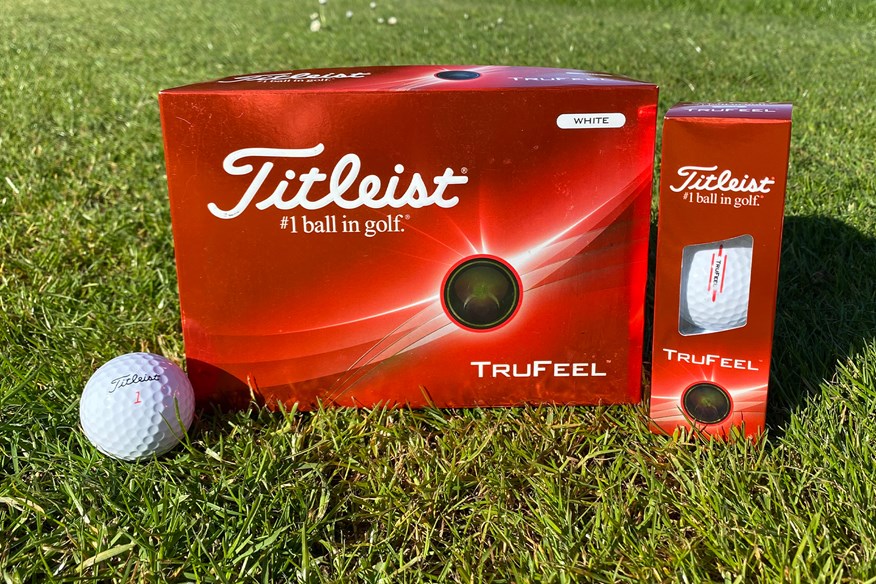

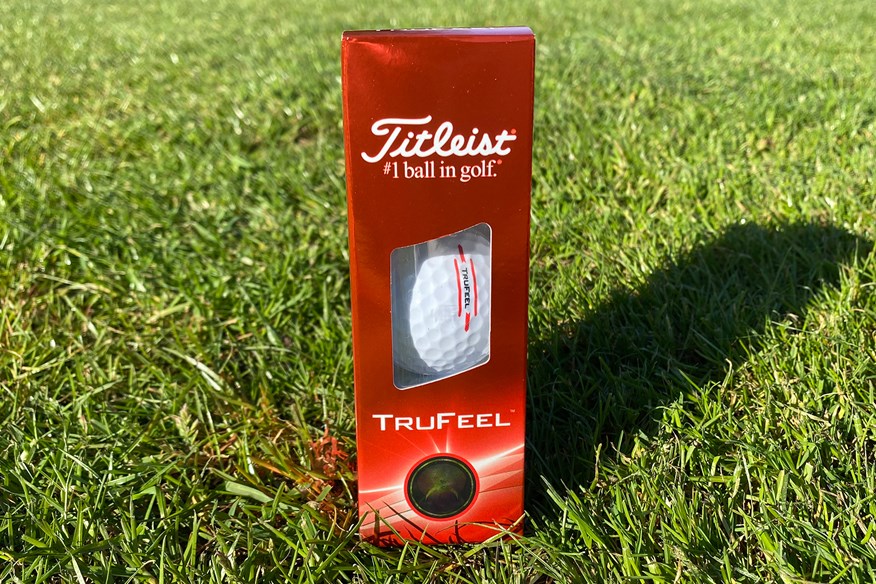
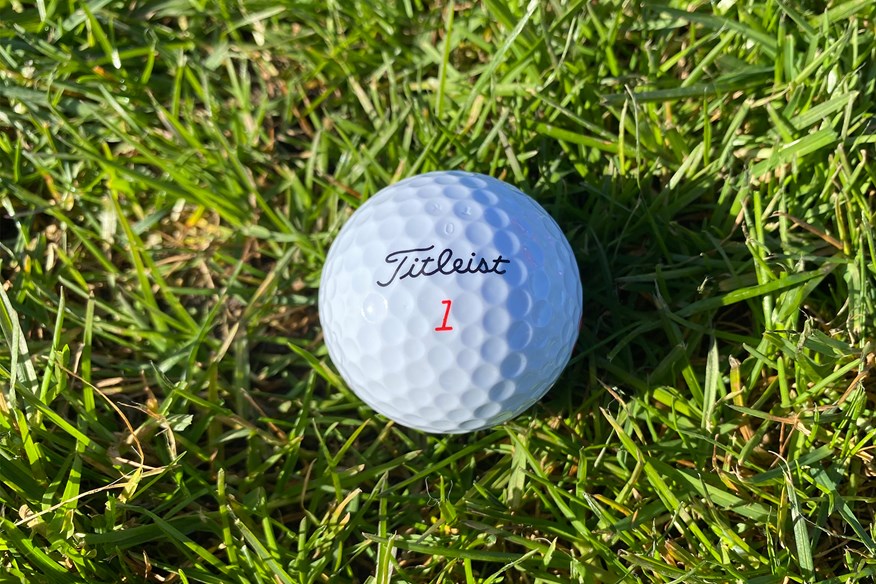
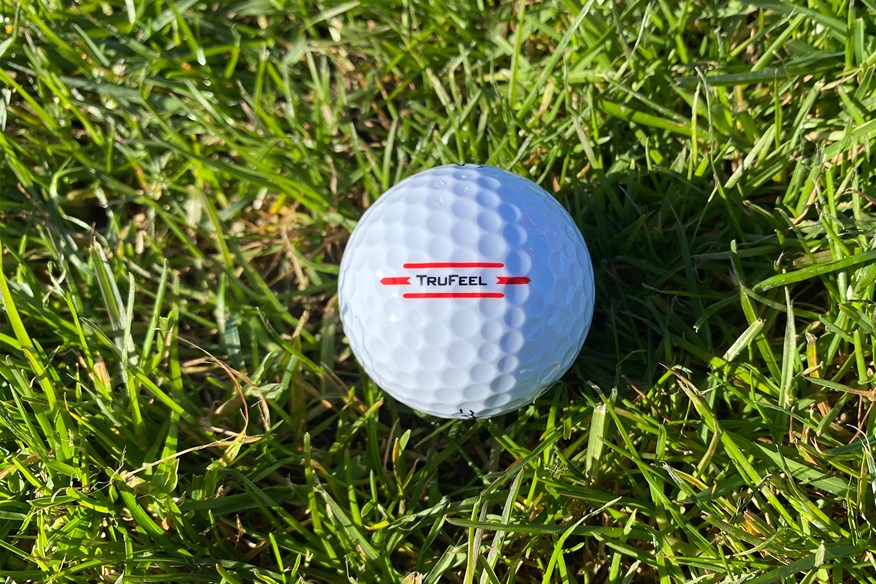
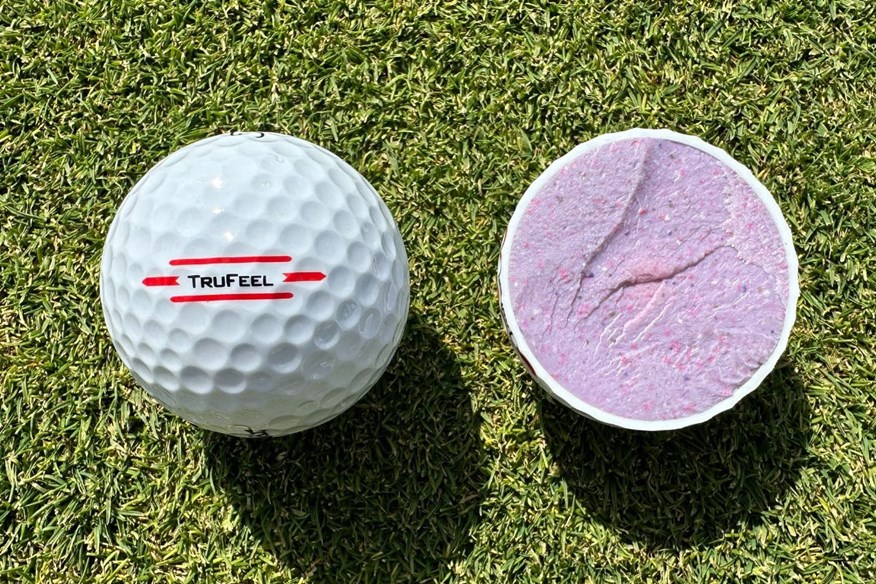
It speaks volumes that Titleist's worst two-piece golf ball is the 10th best two-piece model from our 2025 robot test.
Just because the TruFeel isn't as good a performer as the Tour Soft or Velocity based on the robot testing, doesn't mean it shouldn't be put in play for certain golfers.
The TruFeel has a much lower compression rating (68) than the other two Titleist two-piece models, and that will make it easier to compress for slower swing speed golfers.
If you're not in the market for a lower compression golf ball, I can't see a reason to opt for this golf ball over the Velocity or Tour Soft, if you're looking for a 2-piece Titleist model.
The performance of the TruFeel isn't a million miles off the Tour Soft or Velocity, but it is shorter and slower off the tee at all three driver swing speeds, slower and lower-spinning in approach play performance, and lower-spinning in short game performance.
This is said to be Titleist's softest golf ball, but I don't think soft feel is enough to draw you away from either of Titleist's other two-piece golf balls. Unless feel is everything.
On-course verdict
I'm not one to play with the Titleist TruFeel because it does very little for me. In my opinion, the feel is unpleasantly soft and dull, and the performance doesn't match the levels of the Velocity or Tour Soft.
My on-course experience is very similar to our robot test verdict. I can see why the TruFeel will have its fans; it's a cheap Titleist golf ball.
However, personally, I think spending the extra money on a different golf ball is worthwhile, or switching to the Velocity if you want distance, or Tour Soft if you want spin.
Pros
- Soft feeling will appeal to most golfers
- Not far behind the Tour Soft or Velocity with its performance
- Reasonably priced
Cons
- Difficult to recommend ahead of Tour Soft or Velocity
| Carry distance (yds) | Driver 114mph - 269.1 | Driver 93mph - 207.6 | Driver 78mph - 160.1 | 7-iron - 158.1 |
| Ball speed (mph) | Driver 114mph - 161.9 | Driver 93mph - 133 | Driver 78mph - 112.6 | 7-iron - 108.4 |
| Backspin (rpm) | Driver 114mph - 2,605 | Driver 93mph - 2,506 | Driver 78mph - 2,218 | 7-iron - 4,125 | Pitch - 5,553 |
| Launch angle (°) | Driver 114mph - 11.1 | Driver 93mph - 13.1 | Driver 78mph - 14.4 | 7-iron - 21.8 | Pitch - 31.8 |
| Descent angle (°) | Driver 114mph - 36.1 | Driver 93mph - 31.5 | Driver 78mph - 26.8 | 7-iron - 44.6 | Pitch - 37.7 |
| Peak height (yds) | Driver 114mph - 30.8 | Driver 93mph - 21.9 | Driver 78mph - 15.3 | 7-iron - 29.7 | Pitch - 7.6 |
| Compression (psi) | 68 |
- Reformulated TruTouch core
- Softer 3.0 TruFlex cover
- Spherically-tiled tetrahedral dimple design
- 376 dimples
- 2-Piece construction
- Available in white and yellow
Best two-piece golf balls: Robot test data
| Golf ball | Bridgestone e12 Speed | Callaway Warbird Distance+ | Titleist Tour Soft | Mizuno RB 566 | Titleist Velocity | Srixon Q-Star | Maxfli StraightFli | TaylorMade Distance+ | Seed SD-15 | Titleist TruFeel |
| Compression | 103.0 | 92.0 | 95 | 92 | 101 | 68 | 102 | 95 | 64 | 68 |
| 114mph Driver Ball Speed (mph) | 164.0 | 163.0 | 163.3 | 161.9 | 163.2 | 160.8 | 162.6 | 162.9 | 159.6 | 161.9 |
| 114mph Driver Launch Angle (°) | 11.4 | 11.1 | 11.1 | 11.1 | 11.1 | 11.2 | 11.1 | 11.1 | 11.0 | 11.1 |
| 114mph Driver Backspin (rpm) | 2680 | 2683 | 2776 | 2719 | 2677 | 2685 | 2764 | 2704 | 2612 | 2605 |
| 114mph Driver Carry Distance (yds) | 273.9 | 270.9 | 271.3 | 268.6 | 271.5 | 266.4 | 270.0 | 270.9 | 263.5 | 269.1 |
| 114mph Driver Height (yds) | 33.0 | 31.7 | 32.6 | 31.5 | 31.8 | 30.9 | 32.3 | 32.0 | 29.5 | 30.8 |
| 114mph Driver Descent Angle (°) | 37.6 | 36.8 | 37.6 | 36.9 | 36.9 | 36.5 | 37.5 | 37.1 | 35.4 | 36.1 |
| 93mph Driver Ball Speed (mph) | 134.1 | 133.7 | 133.4 | 133.3 | 133.5 | 132.1 | 134.1 | 133.4 | 131.7 | 133.0 |
| 93mph Driver Launch Angle (°) | 12.9 | 13.0 | 13.0 | 13.0 | 13.2 | 12.7 | 13.0 | 13.0 | 13.0 | 13.1 |
| 93mph Driver Backspin (rpm) | 2574 | 2611 | 2731 | 2553 | 2467 | 2649 | 2575 | 2476 | 2482 | 2506 |
| 93mph Driver Carry Distance (yds) | 209.7 | 209.2 | 208.5 | 207.9 | 208.9 | 204.5 | 210.0 | 208.3 | 204.0 | 207.6 |
| 93mph Driver Height (yds) | 22.3 | 22.5 | 22.8 | 21.9 | 22.2 | 21.3 | 22.5 | 21.8 | 21.1 | 21.9 |
| 93mph Driver Descent Angle (°) | 31.8 | 32.2 | 32.8 | 31.6 | 31.5 | 31.4 | 32.0 | 31.2 | 30.8 | 31.5 |
| 78mph Driver Ball Speed (mph) | 113.2 | 113.0 | 112.8 | 112.6 | 112.9 | 112.4 | 113.1 | 113.0 | 112.0 | 112.6 |
| 78mph Driver Launch Angle (°) | 14.1 | 14.2 | 14.0 | 14.1 | 14.2 | 14.2 | 14.3 | 14.1 | 14.4 | 14.4 |
| 78mph Driver Backspin (rpm) | 2317 | 2346 | 2438 | 2381 | 2261 | 2371 | 2254 | 2314 | 2233 | 2218 |
| 78mph Driver Carry Distance (yds) | 161.3 | 161.3 | 160.4 | 160.2 | 160.6 | 159.9 | 161.3 | 161.0 | 158.9 | 160.1 |
| 78mph Driver Height (yds) | 15.5 | 15.6 | 15.4 | 15.4 | 15.3 | 15.5 | 15.5 | 15.4 | 15.2 | 15.3 |
| 78mph Driver Descent Angle (°) | 27.0 | 27.3 | 27.3 | 27.2 | 26.8 | 27.3 | 27.0 | 27.0 | 26.8 | 26.8 |
| 7-Iron Ball Speed (mph) | 109.2 | 108.7 | 108.3 | 109.1 | 108.7 | 108.0 | 109.5 | 108.5 | 108.3 | 108.4 |
| 7-Iron Launch Angle (°) | 21.3 | 21.6 | 21.1 | 20.7 | 21.9 | 21.5 | 21.0 | 21.2 | 21.7 | 21.8 |
| 7-Iron Backspin (rpm) | 4467 | 4273 | 4774 | 4947 | 3801 | 4387 | 4530 | 4596 | 4170 | 4125 |
| 7-Iron Carry Distance (yds) | 157.6 | 157.9 | 154.2 | 154.8 | 160.6 | 155.8 | 158.0 | 155.7 | 157.6 | 158.1 |
| 7-Iron Height (yds) | 30.0 | 29.9 | 29.5 | 29.6 | 29.6 | 29.5 | 29.8 | 29.6 | 29.6 | 29.7 |
| 7-Iron Descent Angle (°) | 45.1 | 44.9 | 45.2 | 45.3 | 44.0 | 44.8 | 44.9 | 45.1 | 44.6 | 44.6 |
| 40-Yard Pitch Ball Speed (mph) | 46.4 | 46.7 | 46.6 | 46.8 | 46.4 | 46.9 | 46.2 | 45.7 | 46.9 | 47.0 |
| 40-Yard Pitch Launch Angle (°) | 30.7 | 30.7 | 30.4 | 30.6 | 31.2 | 31.4 | 36.5 | 36.5 | 31.4 | 31.8 |
| 40-Yard Pitch Backspin (rpm) | 5951 | 5963 | 6075 | 5960 | 5789 | 5674 | 3742 | 3685 | 5667 | 5553 |
| 40-Yard Pitch Carry Distance (yds) | 39.8 | 40.3 | 40.0 | 40.5 | 40.2 | 41.1 | 41.4 | 40.8 | 41.1 | 41.4 |
| 40-Yard Pitch Height (yds) | 6.9 | 6.9 | 6.8 | 7.0 | 7.1 | 7.3 | 9.1 | 8.9 | 7.3 | 7.6 |
| 40-Yard Pitch Descent Angle (°) | 36.0 | 36.1 | 35.7 | 36.0 | 36.7 | 37.1 | 42.8 | 42.7 | 37.1 | 37.7 |
Best two-piece golf balls 2025: Buying Guide
The two-piece category of golf balls is extremely competitive – as you can see from the number of models in our 2025 robot test. There is a huge variation in performance. Some two-piece golf balls are designed to maximize distance, while others are created purposefully to deliver a soft feeling.
Some two-piece models do have crossovers in their performance, but they’re not all carbon copies of one another. Although there is only a core and cover used to build a two-piece golf ball, manufacturers are still capable of tuning those layers to eek out a certain type of performance. However, it’s more difficult than it is when more layers are in play.
Depending on your needs and requirements from a golf ball, reading through our detailed buying guide will hopefully provide you with some clarity as to which model will work best for you, or if you’ll be better suited to one of the best three-piece or four-piece and five-piece golf balls.
Ability
Two-piece golf balls aren’t exclusive to beginners and high-handicappers, but better players may be more inclined to dismiss two-piece models because they’re viewed as being inferior. However, as our 2025 robot test data shows, that’s not always the case.
Given that two-piece golf balls tend to be the cheapest golf balls on the market, golfers more susceptible to losing golf balls will lean towards two-piece models because they’re not going to be hurt as much when they lose one.
Ability should never be the only factor leading you to purchase a certain golf ball, and if you are a single-figure handicapper or more seasoned golfer, don’t be too proud to consider a two-piece model.
Budget
Two-piece golf balls are the most budget-friendly models in the game. You can pick up a dozen balls for as little as $15 – granted, they might not be the best, but they are an option.
That’s not to say all two-piece models are cheap. And it’s also not to say that cheap two-piece golf balls are worth your hard-earned cash. Take, for instance, the Bridgestone e12 Speed; they’re around $35 for a dozen, but well worth the money because they’re one of, if not the best value golf balls.
Feel
The vast majority of golfers look for soft-feeling golf balls, and within this category, you can find soft and, I would say, not as soft golf balls. It’s seldom the case that non-soft golf balls are firm, as they once were, but firmer golf balls do still exist, even in the two-piece category. Many golfers enjoy soft-feeling golf balls because they deliver a sweet sensation off of every club in the bag – except if you skull one.
I enjoy playing with firmer golf balls like the Wilson Staff Model X and Titleist Pro V1x because I feel as though they provide more feedback and a stronger response. However, feel is completely personal, and like I say, it’s tough to find a super-firm golf ball because most are made to be soft to please the needs of more golfers.
Performance
You won’t find any Tour players using a two-piece golf ball, but that’s not to say you shouldn’t. Two-piece golf balls aren’t the most advanced, but in the right golfer’s hands, they can be as strong as the models you see played on Tour.
What I mean by this is, some golfers might not have the game to unlock all the qualities and performance of a premium golf ball. For instance, I know not to play with one of the best low-spin golf balls because they don’t work for my game. So, for you, a two-piece golf ball could help you play your best golf, and you might not need the extra technology found in three-piece or four-piece and five-piece golf balls.
Two-piece golf balls are more than capable of keeping up with the best distance golf balls, best high-spin golf balls, and the best four and five-piece golf balls. However, it’s rarer for one model to tick all the boxes. Although the results from our mammoth robot test show the Bridgestone e12 Speed is right up there with the best golf balls.
Spin
Given that two-piece golf balls are constructed using an ionomer or surlyn cover, you probably shouldn’t expect a golf ball in this category to spin as high as a golf ball constructed of more layers and sporting a urethane cover. However, that’s not the case with every two-piece model.
By spin, I’m not solely talking about high-spin or low-spin, but optimal spin where required. There are a couple of two-piece models that are surprisingly good in this area.
I’ve seen firsthand how playing with the right golf ball can positively impact spin throughout your bag. During a ball fitting at Titleist, I discovered that a Titleist Pro V1x and Titleist Velocity performed very similarly with my driver, but with a 7-iron, the spin dropped slightly with the Velocity, and then with a 60° wedge, the spin fell massively with the Velocity. In this instance, I wouldn’t play Velocity because it’s not high-spinning around the greens, but I might play with Tour Soft because it is.
Spin in the golf ball comes from the combination of layers within the golf ball reacting with one another, hence why golf balls in the four-piece and five-piece category spin more in approach play because they consist of more layers and the technology is more refined. Whereas golf balls in this category, consisting of only two layers – the cover and core – don’t have the number of layers required to produce astronomical spin when attacking pins.
Another factor I’ve already touched on slightly is the cover material. Every golf ball in this category sports an ionomer or surlyn cover, which doesn’t create as much friction with the clubface as urethane does.
Spin is massively important because it can either make you hit and hold a green or hit and fly over the green. The best golf balls for spin are by far premium golf balls, because they consist of the best golf balls played on Tour. However, some of the best two-piece golf balls can keep up with those in certain areas. If you feel as though you need high levels of spin when attacking greens, have a look at the best high-spin golf balls. Alternatively, if you feel as though spin is hurting your game, check out the best low-spin golf balls.
Distance
I would honestly say that distance is the last factor to consider when purchasing golf balls. The best way to figure out which golf balls are best for you is by working your way back from the green to the tee box. The best way of doing this is with a launch monitor to see your numbers, but if you don’t have access to one, you can do it with your eye very easily.
Start by hitting wedge shots into the green and see which balls are performing best with spin, then work your way back to 7-iron distance and look for the same numbers with slightly more of an eye on carry distance. You should have whittled it down to one or two golf balls, hit them off the tee, and look at which performs the best.
If you’re testing four- or five-piece golf balls up against cheaper golf balls, chances are that a premium golf ball will come out on top. However, you could be surprised. You will find one model that performs well for you, or you might have the luxury of deciding between a handful.
By testing golf balls this way, you’ll end up with the ball that performs best in the short game, which is where you score. Distance is important, but there are other ways of improving distance without sacrificing spin in a golf ball.
Color
The most common golf ball colour is white; however, there are plenty of other colours and designs to choose from. More vibrant colors, such as yellow, orange, or green, are all easy to pick up, and they help some people with visibility – hence why they make for the best winter golf balls.
Other ways of adding colour to the golf ball can be by design, whether it be a splash of colour seen on Vice golf balls or an alignment design which also helps with visibility, such as TaylorMade’s Pix golf balls or Callaway’s Triple Track golf balls.
If you’ve only ever played with white golf balls, it might be worth trying a more colorful golf ball, especially if you’re always the one asking your playing partners, “Where did that one go?”.
Alignment
More and more golf balls are being released with enhanced alignment, and even standard golf balls have a more prominent alignment stamp now than they’ve ever had. The majority of brands now offer golf balls with enhanced alignment aids. The enhanced alignment aids can be extremely useful for putting and even lining up shots on the tee. Another plus of alignment golf balls is the alignment serves as a tool for finding your golf ball either in the air or among the trees.
Best two-piece golf balls: FAQs
What to read next
For performance insights tailored to your swing speed and preferences, head to our results hubs:
- Best 4 and 5-piece golf balls
- Best 3-piece golf balls
- Best golf balls for fast swing speeds
- Best golf balls for average swing speeds
- Best golf balls for slow swing speeds
- Best golf balls for distance
- Best golf balls for approach play
- Best golf balls for short game
- Best golf balls for mid-handicaps
- Best golf balls for beginners
- Most consistent golf balls


